|
Meinem Lehrer und Freund Prof. Dr. Heinrich von Stietencron in Dankbarkeit gewidmet. |
Zitierweise | cite as: Amarasiṃha <6./8. Jhdt. n. Chr.>: Nāmaliṅgānuśāsana (Amarakośa) / übersetzt von Alois Payer <1944 - >. -- 1. Prathamam kāṇḍam. -- 11. vārivargaḥ. -- 2. Vers 25c - 43. -- Fassung vom 2010-12-07. -- URL: http://www.payer.de/amarakosa/amara111b.htm
Erstmals hier publiziert: 2010-09-20
Überarbeitungen: 2010-12-07 [Ergänzungen] ; 2010-11-05 [Ergänzungen] ; 2010-10-26 [Ergänzungen] ; 2010-09-27 [Ergänzungen]
©opyright: Creative Commons Lizenz (Namensnennung, keine kommerzielle Nutzung, share alike)
Dieser Text ist Teil der Abteilung Sanskrit von Tüpfli's Global Village Library
|
Meinem Lehrer und Freund Prof. Dr. Heinrich von Stietencron in Dankbarkeit gewidmet. |
Falls Sie die diakritischen Zeichen nicht dargestellt bekommen, installieren Sie eine Schrift mit Diakritika wie z.B. Tahoma.
Die Devanāgarī-Zeichen sind in Unicode kodiert. Sie benötigen also eine Unicode-Devanāgarī-Schrift.
Jātarūpa
Jātarūpa <vor 1119 n. Chr.>: Jātarūpa's Commentary on the Amarakoṣa : for the first time critically edited together with an introduction, appendices and indices / Mahes Raj Pant. - 2 Bde. -- Delhi [u.a.] : Motilal Banarsidass, 2000. -- Teilw. zugl.: Hamburg, Univ., Diss. von Mahes Raj Pant. -- ISBN 81-208-1690-0
Hardwicke
Gray, John Edward <1800-1875>: Illustrations of Indian zoology : chiefly selected from the collection of Major-General [Thomas] Hardwicke [1755 - 1835]. -- London, 1830-1834. -- 2 Bde. ; 58 cm. -- Online: Internet archive
Hortus malabaricus
Hortus Indicus Malabaricus : continens regni Malabarici apud Indos cereberrimi onmis generis plantas rariores, Latinas, Malabaricis, Arabicis, Brachmanum charactareibus hominibusque expressas ... / adornatus per Henricum van Rheede, van Draakenstein, ... et Johannem Casearium ... ; notis adauxit, & commentariis illustravit Arnoldus Syen ... -- 11 Bde. -- Amstelaedami : sumptibus Johannis van Someren, et Joannis van Dyck, 1678-1703. -- Online: http://www.biodiversitylibrary.org/bibliography/b11939795. -- Zugriff am 2010-01-01
Zu den Identifikationen siehe:
Dillwyn, L. W. (Lewis Weston) <1778-1855>: A review of the references to the Hortus malabaricus of Henry Van Rheede Van Draakenstein [sic]. -- Swansea : Printed at the Cambrian-Office, by Murray and Rees, 1839.
Roxburgh
Roxburgh, William <1751-1815>: Plants of the coast of Coromandel, selected from drawings and descriptions presented to the hon. court of directors of the East India company / by William Roxburgh. Published by their order under the direction of Sir Joseph Banks <1743 - 1820> ... -- London : Printed by W. Bulmer for G. Nicol, 1795-1819. -- 3 Bde. : 300 kolorierte Tafeln ; 59 cm. -- Online: http://www.botanicus.org/title/b12006488 usw. -- Zugriff am 2009-09-19
Thomas, 1881
Thomas, Henry Sullivan: The rod in India : being hints how to obtain sport with remarks on the natural history of fish and their culture and illustrations of fish and tackle. -- 2. ed. -- London : Hamilton, Adams & Co., 1881. -- XXVII, 435 S. : Ill. ; 22 cm. -- Online: http://www.archive.org/details/rodinindiabeingh00thomrich. -- Zugriff am 2010-09-13
Wight Icones
Wight, Robert <1796 - 1872>: Icones plantarum Indiae Orientalis :or figures of Indian plants. -- 6 Bde. -- Madras : published by J.B. Pharoah for the author, 1840-1853. -- Online: http://www.biodiversitylibrary.org/bibliography/92. -- Zugriff am 2010-01-01
Wight Illustrations
Wight, Robert <1796 - 1872>: Illustrations of Indian botany :or figures illustrative of each of the natural orders of Indian plants, described in the author's prodromus florae peninsulae Indiae orientalis. -- 2 Bde. + Suppl. -- Madras : published by J. B. Pharoah for the author, 1840-1850. -- Online: http://www.biodiversitylibrary.org/bibliography/9603. -- Zugriff am 2010-01-01
25. c./d. jalāśayā jalādhārās tatrāgādhajalo hradaḥ
जलाशया जलाधारास् तत्रागाधजलो ह्रदः ॥२५ ख॥
[Bezeichnungen für See, Teich, Wasserreservoir sind:]
जलाशय m.: Wasserort
जलाधार m.: Wasserbehälter
Ein solcher mit tiefem Wasser heißt ह्रद m.: See, Teich, Meer

Abb.: जलाधारः । Goldener Tempel - ਹਰਿਮੰਦਰ ਸਾਹਿਬ, Amritsar -
ਅੰਮ੍ਰਿਤਸਰ, Punjab
[Bildquelle: ©Google Earth. -- Zugriff am 2010-09-16]
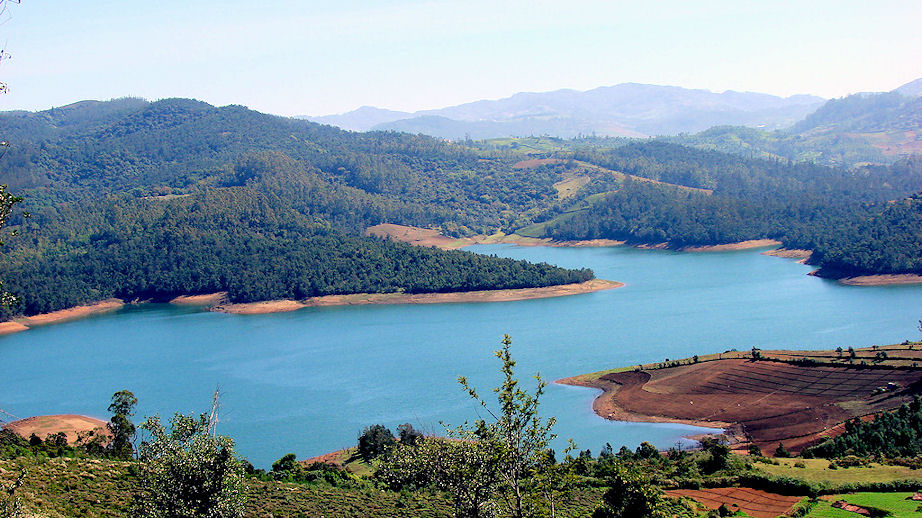
Abb.: ह्रदः । Emerald Lake, Ootacamund -
உதகமண்டலம், Tamil Nadu
[Bildquelle:
Sankara Subramanian. --
http://www.flickr.com/photos/sankaracs/3860105606/. -- Zugriff am
2010-09-16. --
Creative
Commons Lizenz (Namensnennung, keine kommerzielle Nutzung, keine
Bearbeitung)]
26. a./b. āhāvas tu nipānaṃ syād upakūpajalāśaye
आहावस् तु निपानं स्याद् उपकूपजलाशये ।२६ क।
Einen Wasserbehälter in der Nähe eines Brunnens nennt man:
आहाव m.: Eimer, Tränke in Nähe eines Brunnens
निपान n.: Tränke
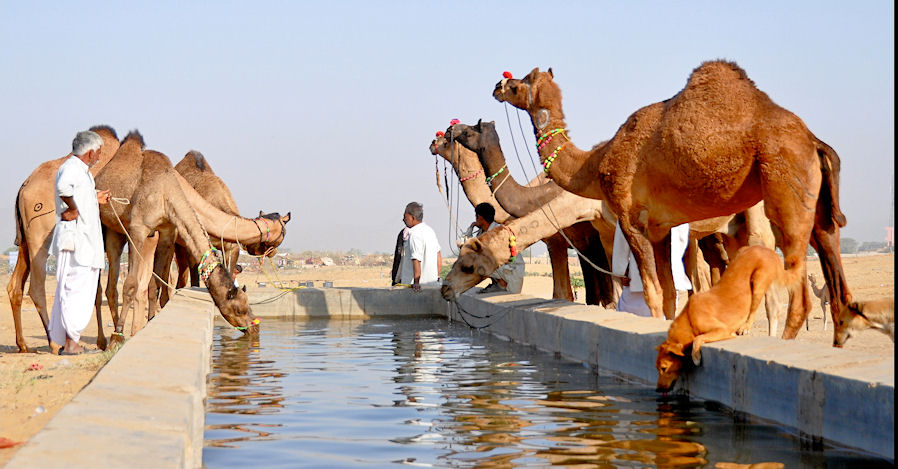
Abb.: निपानम् । Pushkar
[Bildquelle:
Shreyans Bhansali. --
http://www.flickr.com/photos/thebigdurian/4191415495/. -- Zugriff am
2010-09-16. --
Creative
Commons Lizenz (Namensnennung, keine kommerzielle Nutzung, share alike)]
26. c./d. puṃsy evāndhuḥ prahiḥ
kūpa udapānaṃ tu puṃsi vā
27. a./b. nemis trikāsya vīnāho mukhabandhanam asya yat
पुंस्य् एवान्धुः प्रहिः कूप उदपानं तु पुंसि वा ॥२६ ख॥
नेमिस् त्रिकास्य वीनाहो मुखबन्धनम् अस्य यत् ।२७ क।
[Bezeichnungen für Brunnen sind:]
अन्धु m.: "Finsterer", Brunnen
प्रहि m.: "Verschwinder", Brunnen
कूप m.: Grube, Brunnen
उदपान n., m.: "Wassertränke", Brunnen
[Die Vorrichtung, um Wasser aus dem Brunnen zu ziehen heißt1:]
नेमि f.: Radkranz, Felge, Kreis, Rund, Umkreis
त्रिका f. Dreiheit
Der Verschluss der Brunnenöffnung heißt वीनाह m.: Brunnendeckel
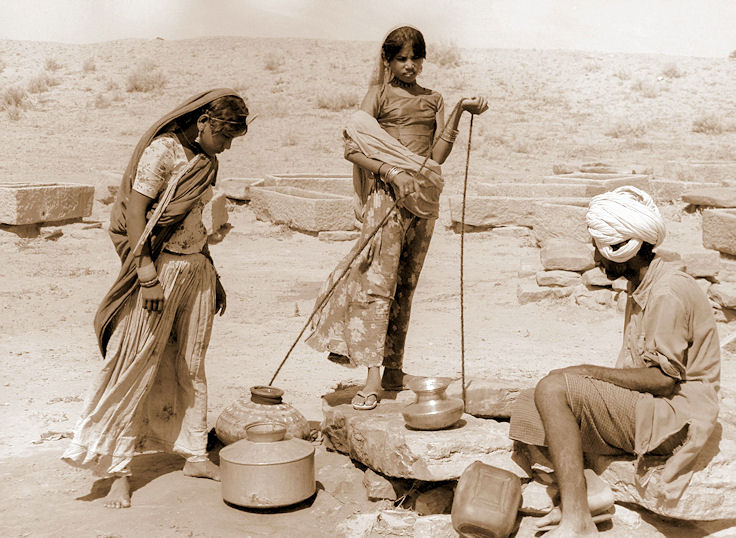
Abb.: कूपः । Wüste Thar -
थार मरुधर, Rajasthan, 1988
[Bildquelle:
Norma Desmond. --
http://www.flickr.com/photos/dramaqueennorma/150458354/. -- Zugriff am
2010-09-16. --
Creative
Commons Lizenz (Namensnennung, keine kommerzielle Nutzung, share alike)]
Erläuterungen:
1 A triangular frame. Some interpret it the wooden frame at the bottom of the well, on which the masonry rests. Others the cover of the well. Or the frame at its mouth.
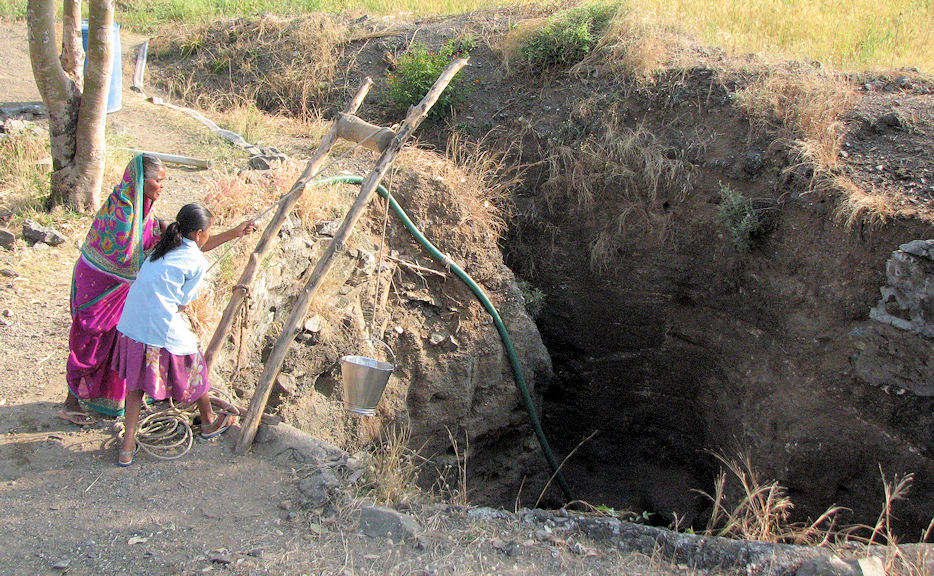
Abb.: नेमिः । त्रिका । Darewadi
[Bildquelle: Robin Murphy, World Resources Institute. --
http://www.flickr.com/photos/worldresourcesinstitute/2555779241/. -- Zugriff
am 2010-09-16. --
Creative
Commons Lizenz (Namensnennung, keine kommerzielle Nutzung, share alike)]
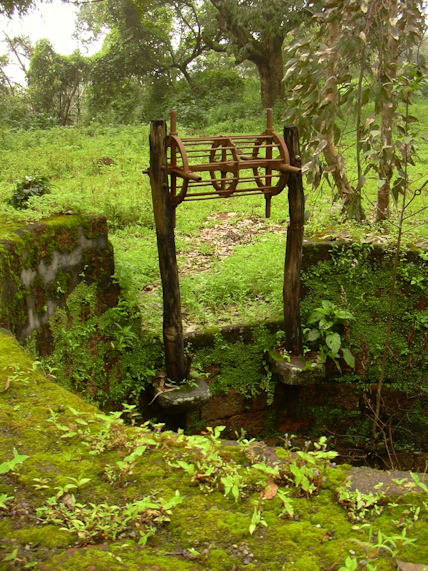
Abb.: नेमिः । त्रिका । Panchagani,
Maharashtra
[Bildquelle:
Harshad Sharma. --
http://www.flickr.com/photos/harshadsharma/40905020/. -- Zugriff am
2010-09-16. --
Creative
Commons Lizenz (Namensnennung, keine kommerzielle Nutzung, keine
Bearbeitung)]
27. c./d. puṣkariṇyāṃ tu khātaṃ
syād akhātaṃ devakhātakam
28. padmākaras taḍāgo 'strī kāsāraḥ sarasī saraḥ
veśantaḥ palvalaṃ cālpasaro
vāpī tu dīrghikā
29. kheyaṃ tu parikhādhāras tv ambhasāṃ yatra dhāraṇam
syād ālavālam āvālam
āvāpo 'tha nadī sarit
पुष्करिण्यां तु खातं स्याद् अखातं
देवखातकम् ॥२७ ख॥
पद्माकरस् तडागो
ऽस्त्री कासारः सरसी सरः ।
वेशन्तः पल्वलं चाल्पसरो वापी तु दीर्घिका ॥२८॥
खेयं तु परिखाधारस् त्व् अम्भसां यत्र धारणम् ।
स्याद् आलवालम् आवालम् आवापो
ऽथ नदी सरित्
॥२९॥
Ein Lotusteich (पुष्करिणी f.: Lotusteich) heißt खात n.: Gegrabenes, künstlicher Teich, Grube, Brunnen, Höhle.
Ein nicht gegrabener (d.h. künstlicher) Teich heißt देवखातक n.: von einem Gott Gegrabenes, natürlicher Teich, natürliche Höhle.
Ein mit Lotussen übersäter Teich (पद्माकर m.) heißt तडाग m., n.: Lotusteich, Teich.
Bezeichnungen für Teich sind:
कासार m.: Teich, See
सरसी f.: Teich
सरस् n.: Wasserbehälter, Trog, Becken, See, Teich
[Bezeichnungen für einen kleinen Teich (der in der heißen Jahreszeit austrocknet) sind:]
वेशन्त m.: Teich
पल्वल Teich, Pfuhl
अल्पसरस् n.: kleiner Teich
[Bezeichnungen für einen großen Teich sind:]
वापी f.: Teich, Zisterne
दीर्घिका f.: großer Teich
[Bezeichnungen für Graben sind:]
खेय n.: zu Grabendes, Graben
परिखा f.: rundum Gegrabene, Festungsgraben, Tiefe
Wo aber Wasser zurückgehalten wird, nennt man das आधार m.: Deich, Damm.
[Bezeichnungen für einen Bewässerungsgraben um einen Baum herum sind:]
आलवाल n.: Bewässerungsgraben um einen Baum herum
आवाल n.: Bewässerungsgraben um einen Baum herum
आवाप m.: Bestreuer
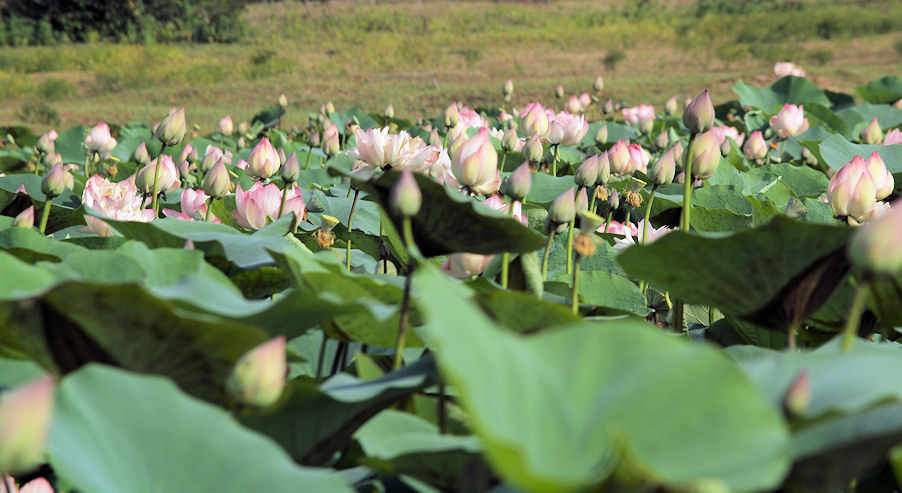
Abb.: तडागः । Chennai
[Bildquelle:
Raj. --
http://www.flickr.com/photos/prince_tigereye/1463770101/. -- Zugriff am
2010-09-17. --
Creative Commons Lizenz (Namensnennung)]
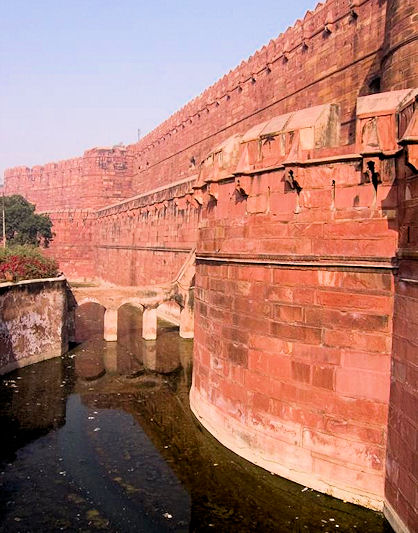
Abb.: परिखा । Agra
[Bildquelle:
sng. --
http://www.flickr.com/photos/luxagraf/124126208/. -- Zugriff am 2010-09-17.
-- Creative
Commons Lizenz (Namensnennung, keine kommerzielle Nutzung, share alike)]
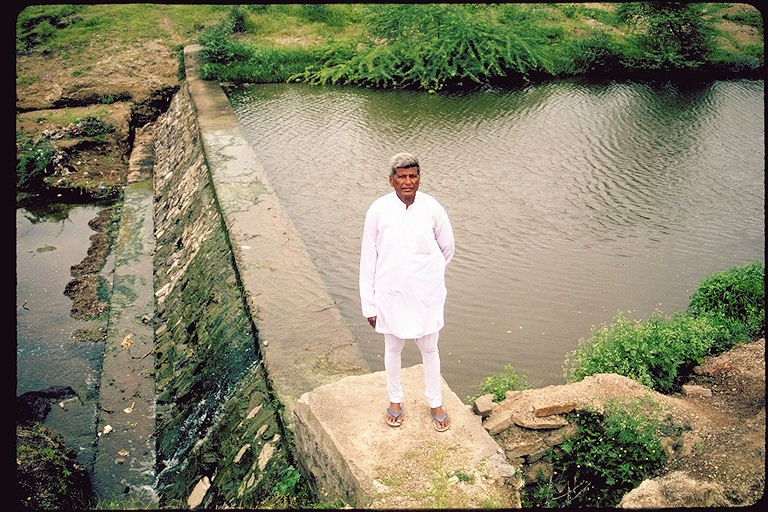
Abb.: आधारः ।
[Bildquelle:
International Rivers. --
http://www.flickr.com/photos/internationalrivers/3439556740/. -- Zugriff am
2010-09-17. --
Creative
Commons Lizenz (Namensnennung, keine kommerzielle Nutzung, share alike)]
29. c./d. syād ālavālam āvālam āvāpo
'tha nadī sarit
30. taraṅgiṇī śaivalinī taṭinī hrādinī dhunī
srotasvinī dvīpavatī
sravantī nimnagāpagā
स्याद् आलवालम् आवालम् आवापो
ऽथ नदी सरित् ॥२९ ख॥
तरङ्गिणी शैवलिनी तटिनी ह्रादिनी धुनी ।
स्रोतस्विनी द्वीपवती स्रवन्ती निम्नगापगा ॥३०॥
[Bezeichnungen für Fluss sind:]
नदी f.: "Brüllerin", Fluss
सरित् f.: Fließende, Fluss
तरङ्गिणी f.: "Wogende", Fluss
शैवलिनी f.: die an Blyxa octandra (Roxb.) Planchon ex Thwaites - Fadenkraut - (einer Wasserpflanze) Reiche1
तटिनी f.: die Uferreiche
ह्रादिनी f.: die Lärmende
धुनी f.: die Rauschende
स्रोतस्विनी f.: die Strömungsreiche
द्वीपवती f.: die Inselreiche2
स्रवन्ती f.: Fließende, Fluss
निम्नगा f.: die zum Tal Gehende
अपगा f.: die abwärts Gehende
Erläuterungen:
1 शैवलिनी f.: die an Blyxa octandra (Roxb.) Planchon ex Thwaites - Fadenkraut - (einer Wasserpflanze) Reiche
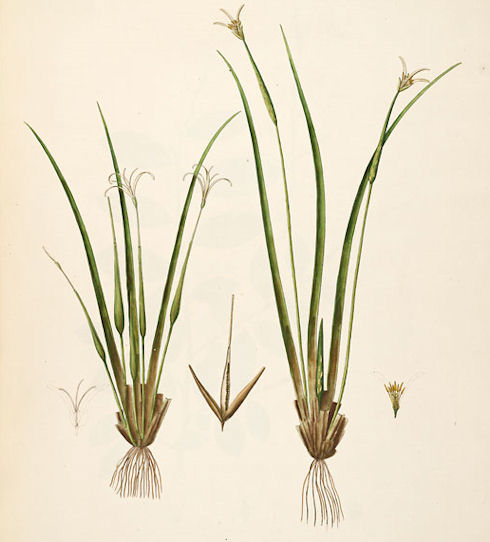
Abb.: शैवलः । Blyxa
octandra (Roxb.) Planchon ex Thwaites - Fadenkraut
[Bildquelle: Plants of the coast of Coromandel : selected from drawings and
descriptions presented to the hon. court of directors of the East India Company
/ by William Roxburgh [u. a.]. -- 1795 - 1819]
2 द्वीपवती f.: die Inselreiche
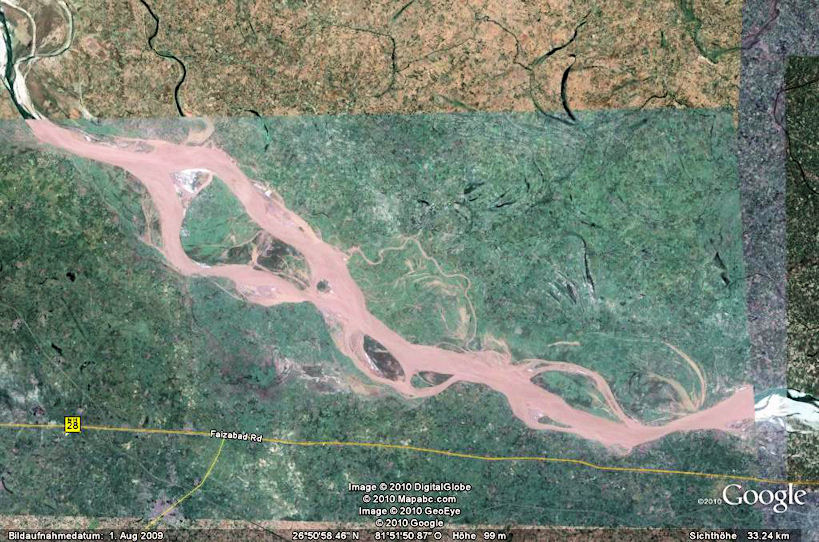
Abb.: द्वीपवती । Ghagara - घाघरा bei Faizabad - फ़ैज़ाबाद, U. P.
[Bildquelle: ©Google Earth. -- Zugriff am 2010-09-17]
31. gaṅgā viṣṇupadī jahnutanayā
suranimnagā
bhāgīrathī tripathagā trisrotā bhīṣmasūr api
गङ्गा विष्णुपदी जह्नुतनया
सुरनिम्नगा ।
भागीरथी त्रिपथगा त्रिस्रोता भीष्मसूर् अपि ॥३०॥
[Bezeichnungen für den Ganges sind:]
गङ्गा f.: Gaṅgā, Ganges1
विष्णुपदी f.: Fuss Viṣṇus
जह्नुतनया f.: Tochter Jahnus2
सुरनिम्नगा f.: Götterfluss
भागीरथी f.: Tochter des Bhagīratha3
त्रिपथगा f.: die drei Wege Gehende4
त्रिस्रोतस् f.: die aus drei Flüssen besteht4
भीष्मसू f.: Mutter des Bhīṣma5
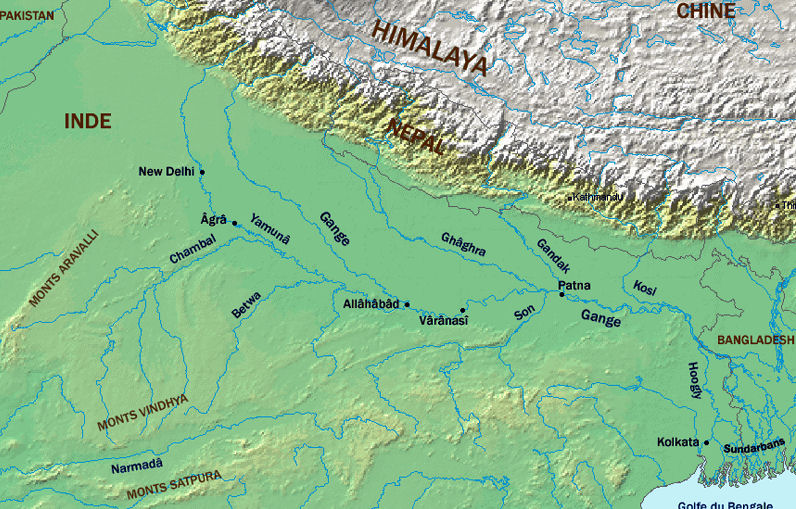
Abb.: गङ्गा ।
[Bildquelle: Nataraja / Wikipedia. -- GNU FDLicense]
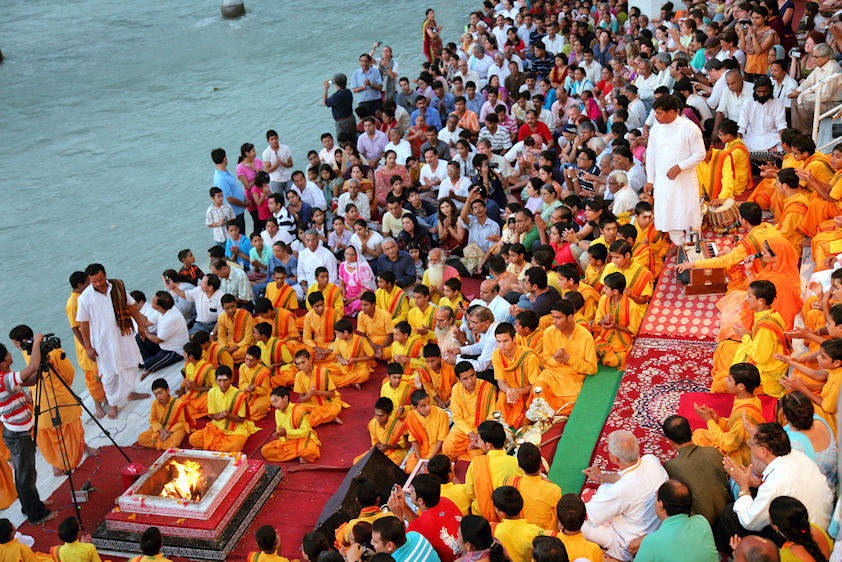
Abb.: गङारती । Rishikesh -
ऋषिकेश,
Uttarakhand
[Bildquelle:
Naresh Rao. --
http://www.flickr.com/photos/nareshrao/3994300401/. -- Zugriff a,
2010-09-17. --
Creative Commons Lizenz (Namensnennung, keine kommerzielle Nutzung)]
Erläuterungen:
1 गङ्गा f. - Gaṅgā
| Ganges | |
| River | |
| Countries | India, Bangladesh |
|---|---|
| States | Uttarakhand, Uttar Pradesh, Bihar, Jharkhand, West Bengal |
| Tributaries | |
| - left | Mahakhali, Karnali, Koshi, Gandak, Ghaghra |
| - right | Yamuna, Son, Mahananda |
| Cities | Haridwar, Kanpur, Allahabad, Varanasi, Ghazipur, Patna, Kolkata |
| Source | Gangotri Glacier |
| - location | Uttarakhand, India |
| - elevation | 7,756 m (25,446 ft) |
| - coordinates | 30°59′N 78°55′E / 30.983°N 78.917°E |
| Mouth | Ganges Delta |
| - location | Bay of Bengal, Bangladesh & India |
| - elevation | 6 m (20 ft) |
| - coordinates | 22°05′N 90°50′E / 22.083°N 90.833°E |
| Length | 2,510 km (1,560 mi) |
| Basin | 907,000 km² (350,195 sq mi) |
| Discharge | mouth |
| - average | 12,015 m3/s (424,306 cu ft/s) |
Quelle der Tabelle:
http://en.wikipedia.org/wiki/Ganges. -- Zugriff am 2010-09-17
"Ganges (im Sanskrit Ganga), der Hauptstrom Britisch-Indiens (s. Karte »Ostindien«), entspringt als Bhagirathi im Distrikt Garhwal der Nordwestprovinzen unter 30°56' nördl. Br. und 79°7' östl. L. unter einem 90 m starken Gletscherrand oberhalb des hochheiligen Wallfahrtsorts Gangotri (s.d.) in 4205 m Höhe, zwischen Bergriesen von 7000 m, nimmt links den ansehnlichen Julkar, weiterhin Tehri und Bhillung auf, vereinigt sich mit der Dschahnawi und bei dem berühmten Wallfahrtsort Deoprajag mit dem ansehnlichen, aus Wischnuganga und Dhauli entstandenen Alakananda und heißt fortan G. Nun fällt er stark bis zu dem heiligen Hardwar (403 m), wo er in das Tiefland eintritt. Er nimmt dann links die beträchtliche Ramganga auf und 1075 km von der Quelle, bei Allahabad (97 m), die fast ebenbürtige Dschamna (s.d.), die ihn von seinem Quellgebiet an in gleicher Richtung begleitet und mit ihm das Doab (s.d.) oder Zweistromland einschließt. Die Landzunge an der Vereinigung beider Flüsse ist die heiligste der fünf heiligen Mündungsstellen (Prajaga), zu der jährlich Hunderttausende pilgern. Das Gefälle beträgt von Hardwar bis Allahabad 0,22 m, von Allahabad bis Kalkutta 0,05 m auf 1 km. Von Allahabad an läuft der Strom, anfangs sehr gewunden, wesentlich nach O., berührt Benares, wo er in der trocknen Jahreszeit 426 m breit, 7,5 m tief ist (in der Regenzeit das Doppelte) und in der Sekunde eine Wassermasse von 589 cbm entladet, und empfängt neben kleinern Zuflüssen (Tonsi, Gumti, Karmanasa) links die der Dschamna an Größe vergleichbare Gogra, während von S. der Son zufließt. Vom Himalaja strömen ihm der ansehnliche Gandak (s.d.) und der Kusi (unterhalb Bhagalpur) zu. Die Breite des G. ist hier auf mehr als 1500 m angewachsen, die Wassermenge bei Radschmahal ist im Maximum 50,400 cbm, sein Bett aber nach der Umlenkung nach SO. unterhalb Sahibgang nur 1,5, ja stellenweise kaum 1/2 m tief. Nun tritt er in die Tiefebene von Bengalen ein und beginnt sich zu verzweigen. Die Hauptmasse des Flusses behält als Padda (Padma) oder G. Südostrichtung und vereinigt sich bei Goalanda mit dem Brahmaputra, von hier an Meghna genannt. Die bedeutendste der Verzweigungen ist die Bhagirathi (nach Vereinigung mit der Dschalanglais Hugli). Sie bleibt 160 km landeinwärts für Seeschiffe fahrbar und fällt, an Kalkutta vorbei, bei der Sagarinsel mit breiter Mündung ins Meer. Der mittlere der acht Hauptarme ist der Mudhumati, an der Mündung Haringhata genannt. Die Werder des eigentlichen Mündungslandes sind die Sunderbands (s.d.) zwischen Hugli im W. und Meghna im O., ein Labyrinth von Schlamm- und Sandinseln, gebildet durch zahllose Stromadern und Rinnsale. Der 2500 km lange G. steht dem Indus und Brahmaputra an Länge nach, voran aber in der Ausdehnung seines Gebiets (1 Mill. qkm), der mittlern jährlichen Wassermasse (7700 cbm in der Sekunde) und der Menge der Sinkstoffe (197 Mill. cbm); die durch letztere bewirkte Färbung des Meeres reicht bis 100 km von der Küste. Im Mai beginnt der Fluß zu steigen und erreicht im September seine größte Höhe, bei Allahabad 8,8–13,9, bei Benares 10,4–13,7, bei Golgong 8,6–9, bei Kalkutta 2–2,18 m. Ende Juli ist das ganze Mündungsgebiet ein großer See, aus dem nur Dörfer und Bäume hervorragen. Weite Landstriche sind durch Dämme geschützt.
Die Uferlandschaften des G. sind mit einer üppigen subtropischen Vegetation bedeckt; Reis, Weizen, Gerste, Opium, Indigo, Baumwolle, Jute etc. ergeben reiche Ernten. Der G. ist reich an Fischen, Schildkröten und Krokodilen (Gavialen). Befahren kann man ihn mit Flößen bis Hardwar. Seit 1834 gehen eiserne Dampfer bei Hochwasser bis Garhmukhtisar, 630 km oberhalb Allahabad; in der trocknen Jahreszeit hindern Untiefen und Stromschnellen die Schiffahrt oberhalb Khanpur, die jedoch sehr bedeutend ist und auch durch die Eisenbahn, die fast das ganze linke Ufer begleitet, nicht gelitten hat, da nun der schnell gestiegene Verkehr von Massengütern den Fluß allein in Anspruch nimmt. Für Schiffahrt und Bewässerung ist von größter Wichtigkeit der 1848 begonnene Gangeskanal, der von Hardwar südwärts über Nanun im Distrikt Aligarh einerseits nach Khanpur in den G., anderseits über Etawah in die Dschamna mündet. Er ist 1305 km lang und hat, einschließlich aller Nebenkanäle, 5,750,000 Pfd. Sterl. gekostet. Eine Fortsetzung bildet der Untere Gangeskanal, der den ganzen südlichen Teil des Doab bewässern und mit allen Verzweigungen 688 km lang werden soll. Im Naturdienst der Inder nimmt das Wasser des G. als reinigend und sühnend eine hohe Stelle ein; schon in der alten Überlieferung (Strom der Götter) gilt der G., die Ganga, als besonders heilig. Dargestellt wird er als junge Frau mit einer Lotosblume in der Hand. Noch heute ist er das Ziel zahlreicher Pilger, die sich von ihren Sünden rein zu baden suchen. Der Versand von Gangeswasser bildet einen sehr einträglichen Handel der Brahmanen. Wer an seinem Ufer stirbt oder vor dem Tode sein Wasser trinkt, ist des Paradieses sicher. Früher warfen die Hindu ganz allgemein ihre Toten in den G.; seit die englische Regierung ein strenges Verbot dagegen erlassen hat, geschieht dies nur noch mit der Asche der freilich oft sehr unvollständig verbrannten Leichen."
[Quelle: Meyers großes Konversations-Lexikon. -- DVD-ROM-Ausg. Faksimile und Volltext der 6. Aufl. 1905-1909. -- Berlin : Directmedia Publ. --2003. -- 1 DVD-ROM. -- (Digitale Bibliothek ; 100). -- ISBN 3-89853-200-3. -- s.v.]
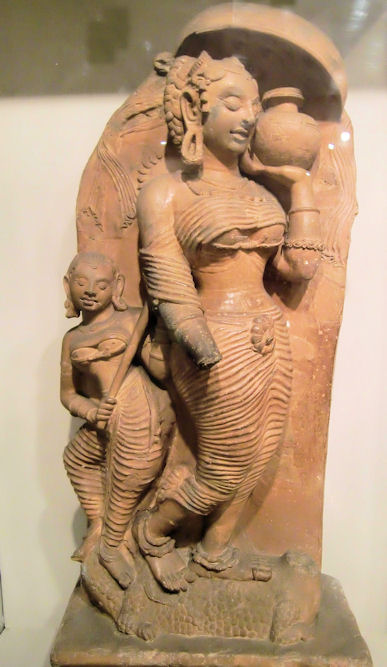
Abb.: गङ्गा ।
[Bildquelle: Miya.m / Wikipedia. -- GNU FDLicense]
"GAṄGĀ. The sacred river Ganges. It is said to be mentioned only twice in the Ṛg-veda. The Purāṇas represent the Viyad-gaṅgā, or heavenly Ganges, to flow from the toe of Viṣṇu, and to have been brought down from heaven, by the prayers of the saint Bhagīratha, to purify the ashes of the sixty thousand sons of King Sagara, who had been burnt by the angry glance of the sage Kapila. From this earthly parent the river is called Bhāgīrathī. Gaṅgā was angry at being brought down from heaven, and Śiva, to save the earth from the shock of her fall, caught the river on his brow, and checked its course with his matted locks. From this action he is called Gaṅgā-dhara, 'upholder of the Ganges'. The river descended from Śiva's brow in several streams, four according to some, and ten according to others, but the number generally accepted is seven, being the Sapta-sindhava, the 'seven sindhus or rivers'. The Ganges proper is one of the number. The descent of the Ganges disturbed the sage Jahnu as he was performing a sacrifice, and in his anger he drank up the waters, but he relented and allowed the river to flow from his ear, hence the Ganges has the name of Jāhnavī. Personified as a goddess, Gaṅgā is the eldest daughter of Himavat and Menā, and her sister was Umā. She became the wife of King Śāntanu and bore a son, Bhīṣma; who is also known by the metronymic Gāngeya. Being also, in a peculiar way, the mother of Kārtikeya (q.v.), she is called Kumāra-sū. Gold, according to the Mahā-bhārata, was borne by the goddess Gaṅgā to Agni, by whom she had been impregnated. Other names and titles of the Ganges are Bhadra-somā, Gāndinī, Kirātī, Deva-bhūti, 'produced in heaven'; Hara-śekharā, 'crest of Śiva'; Khāpagā, 'flowing from heaven'; Mandākinī, 'gently flowing ; Tri-patha-gā or Tri-śrotaḥ, 'triple flowing', running in heaven, earth, and hell."
[Quelle: Dowson, John <1820-1881>: A classical dictionary of Hindu mythology and religion, geography, history, and literature. -- London, Trübner, 1879. -- s.v.]
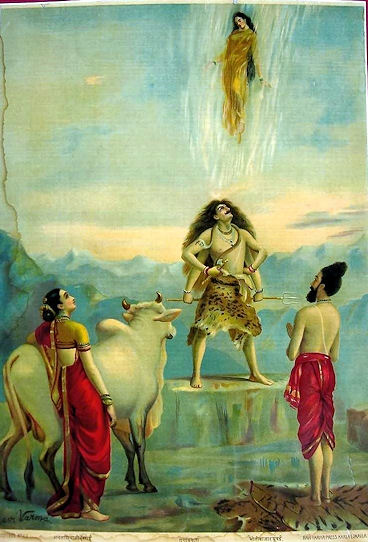
Abb.: गङ्गाधरः ।
Von Raja Ravi Varma (രാജാ രവി വര്മ) (1848
- 1906)

Abb.: गङ्गादेवी । Varanasi - वाराणसी
[Bildquelle: Bala Subs / Wikimedia. --
Creative Commons Lizenz (Namensnennung, share alike)]
2 जह्नुतनया f.: Tochter Jahnus
"JAHNU. A sage descended from Pururavas. He was disturbed in his devotions by the passage of the river Gaṅgā, and consequently drank up its waters. He afterwards relented, and allowed the stream to issue from his ear, hence Gaṅgā is called Jāhnavī, 'daughter of Jahnu'. See Gaṅgā." [Quelle: Dowson, John <1820-1881>: A classical dictionary of Hindu mythology and religion, geography, history, and literature. -- London, Trübner, 1879. -- s.v.]
3 भागीरथी f.: Tochter des Bhagīratha
"BHĀGĪRATHĪ. The Ganges. The name is derived from Bhagīratha, a descendant of Sagara, whose austerities induced Śiva to allow the sacred river to descend to the earth for the purpose of bathing the ashes of Sagara's sons, who had been consumed by the wrath of the sage Kapila. Bhagīratha named the river Sāgarā, and after leading it over the earth to the sea, he conducted it. to Pātāla, where the ashes of his ancestors were laved with its waters and purified."
[Quelle: Dowson, John <1820-1881>: A classical dictionary of Hindu mythology and religion, geography, history, and literature. -- London, Trübner, 1879. -- s.v.]
4 त्रिपथगा f.: die drei Wege Gehende ; त्रिस्रोतस् f.: die aus drei Flüssen besteht
nämlich im Himmel, auf Erden und in der Hölle
5 भीष्मसू f.: Mutter des Bhīṣma
"BHĪṢMA. 'The terrible'. Son of King Śāntanu by the holy river goddess Gaṅgā, and hence called Śāntanava, Gāngeya, and Nadī-ja, 'the river-born'. When King Śāntanu was very old he desired to marry a young and beautiful wife. His son Śāntanava or Bhīṣma found a suitable damsel, but her parents objected to the marriage because Bhīṣma was heir to the throne, and if she bore sons they could not succeed. To gratify his father#s desires, he made a vow to the girl#s parents that he would never accept the throne, nor marry a wife, nor become the father of children. Śāntanu then married the damsel, whose name was Satyavatī, and she bore him two sons. At the death of his father, Bhīṣma placed the elder son upon the throne, but he was headstrong and was soon killed in battle. The other son, named Vicitra-vīryya, then succeeded, and Bhīṣma acted as his protector and adviser. By force of arms Bhīṣma obtained two daughters of the king of Kāśī and married them to Vicitra-vīryya, and when that prince died young and childless, Bhīṣma acted as guardian of his widows. By Bhīṣma's arrangement, Kṛṣṇa Dvaipāyana, who was born of Satyavatī before her marriage, raised up seed to his half-brother. The two children were Pāṇḍu and Dhṛta-rāṣṭra, Bhīṣma brought them up and acted for them as regent of Hastinā-pura. He also directed the training of their respective children, the Pāṇḍavas and Kauravas. On the rupture taking place between the rival families, Bhīṣma counselled moderation and peace. When the war began he took the side of the Kauravas, the sons of Dhṛta-rāṣṭra, and he was made commander-in-chief of their army. He laid down some rules for mitigating the horrors of war, and he stipulated that he should not be called upon to fight against Arjuna. Goaded by the reproaches of Dur-yodhana, he attacked Arjuna on the tenth day of the battle. He was unfairly wounded by Śikhandin, and was pierced with innumerable arrows from the hands of Arjuna, so that there was not a space of two fingers breadth left unwounded in his whole body, and when he fell from his chariot he was upheld from the ground by the arrows and lay as on a couch of darts. He was mortally wounded, but he had obtained the power of fixing the period of his death, so he survived fifty-eight days, and delivered several long didactic discourses. Bhīṣma exhibited throughout his life a self-denial, devotion, and fidelity which remained unsullied to the last. He is also known by the appellation Tarpaṇecchu, and as Tāla-ketu, 'palm banner'. See Mahābhārata."
[Quelle: Dowson, John <1820-1881>: A classical dictionary of Hindu mythology and religion, geography, history, and literature. -- London, Trübner, 1879. -- s.v.]
32. a./b. kālindī sūryatanayā yamunā śamanasvasā
कालिन्दी सूर्यतनया यमुना शमनस्वसा ।३२ क।
[Bezeichnungen für die Yamunā1 sind:]
कालिन्दी f.: Tochter des Kalinda (Sonne)
सूर्यतनया f.: Tochter der Sonne
यमुना f.: Yamunā1
शमनस्वसृ f.: Schwester des Śamana (Yamas)2
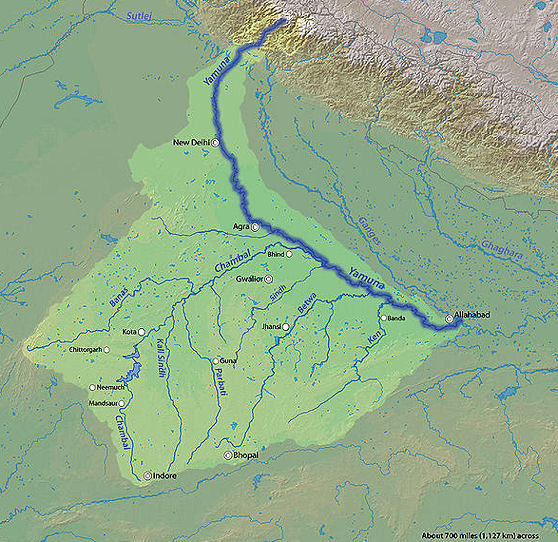
Abb.: यमुना ।
[Bildquelle: Shannon / Wikipedia. -- GNU FDLicense]
Erläuterungen:
1 यमुना f.: Yamunā
| Yamuna (Jamuna) | |
| River | |
| Country | India |
|---|---|
| States | Uttar Pradesh, Uttarakhand, Haryana |
| Tributaries | |
| - left | Chambal, Betwa, Ken, Sindh |
| - right | Tons, Hindon, Sarda, Kunta, Giri, Rishiganga, Hanuman Ganga, Kunta |
| Cities | Delhi, Mathura, Agra, Etawah, Kalpi |
| Source | Yamunotri Glacier |
| - location | Banderpooch peaks, Uttarkashi district, Uttarakhand, India |
| - elevation | 6,387 m (20,955 ft) |
| - coordinates | 38°59′N 78°27′E / 38.983°N 78.45°E |
| Mouth | Triveni Sangam |
| - location | Allahabad, India |
| - elevation | 0 m (0 ft) |
| - coordinates | 25°30′N 81°53′E / 25.5°N 81.883°E |
| Length | 1,376 km (855 mi) |
| Basin | 366,223 km² (141,399 sq mi) |
Quelle der Tabelle:
http://en.wikipedia.org/wiki/Yamuna. -- Zugriff am 2010-09-17
"Dschamna (Dschamuna, engl. Jumna), Nebenfluß des Ganges, entspringt in Garwhal am Himalaja an den 6326 m hohen Dschamnotri Piks unter 31°5´ nördl. Br. und 78°30´ östl. L. in 3306 m Höhe, nahe dem heiligen ð Dschamnotri (s. d.), läuft dem Ganges parallel, bis sie nach 1400 km langem Lauf bei Allahabad in ihn mündet. Beide Flüsse schließen das fruchtbare Doab ein. Die D. teilt sich schon früh in mehrere Arme; Kanäle sind von ihr abgeleitet, teils zur Bewässerung, teils zur Erleichterung der Schiffahrt, die auf der D. oberhalb Dehli sogar unmöglich wird: links der 260 km lange Doab- oder Östliche Dschamnakanal, rechts nach W. der 1356 von Firoz-Schah, König von Dehli, gezogene Kanal, von dem 22 km unterhalb der Kanal von Ali Mardan-Chan südwärts nach Dehli abbiegt, jetzt Westlicher Dschamnakanal genannt; er hat 500 km Haupt- und 417 km Verteilungskanäle, bewässert 150,000 Hektar Land und kostete 31 Mill. Rupien. Unter den Zuflüssen der D. ist der Tschambal der ansehnlichste. Außerdem nimmt sie rechts Sindh, Betowa und Kent, links Hindan, Sengur und Rind auf. Von Eisenbahnen wird die D. überschritten bei Allahabad, Agra, Dehli, Sirsawa. Beim Zusammenfluß ist sie dem Ganges an Wasserfülle gleich. Dem Hindu ist sie ein heiliger Strom, namentlich findet sich bei ihrer Mündung eine Stelle (Prajaga), wo die Hindupilger unter Leitung von Brahmanen baden." [Quelle: Meyers großes Konversations-Lexikon. -- DVD-ROM-Ausg. Faksimile und Volltext der 6. Aufl. 1905-1909. -- Berlin : Directmedia Publ. --2003. -- 1 DVD-ROM. -- (Digitale Bibliothek ; 100). -- ISBN 3-89853-200-3. -- s.v.]
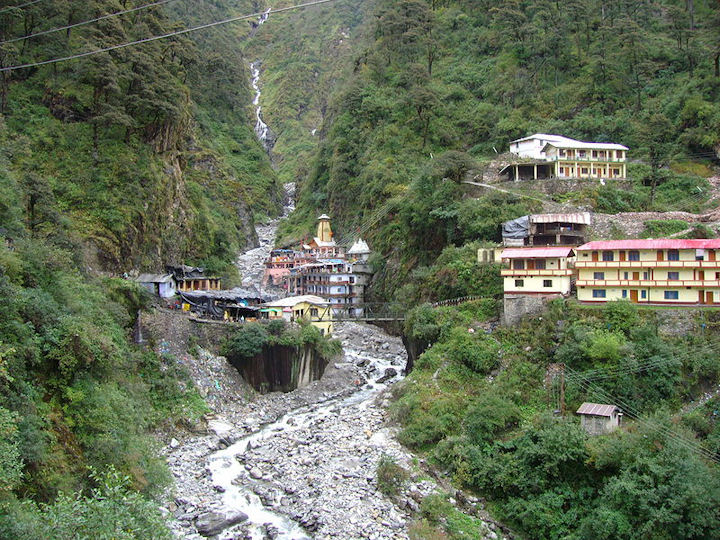
Abb.: Yamunotri - यमुनोत्री,
Uttarakhand
[Bildquelle: Atarax42 / Wikipedia. -- GNU
FDLicense]
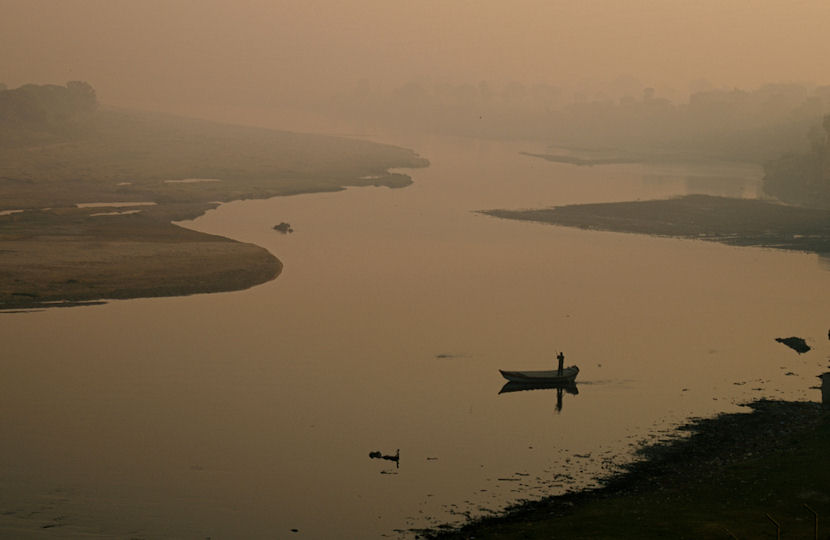
Abb.: यमुना । Agra -
आगरा
[Bildquelle:
Angus MacRae. --
http://www.flickr.com/photos/36176995@N05/3553055288/. -- Zugriff am
2010-09-17. --
Creative Commons Lizenz (Namensnennung)]
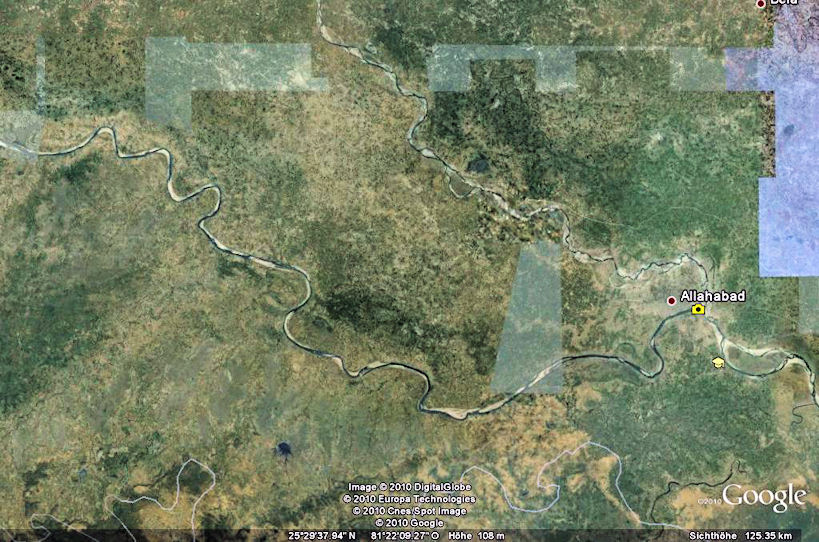
Abb.: Yamunā (unten) und Gaṅgā vor Allahabad -
इलाहाबाद
-
اللہآباد)
[Bildquelle: ©Google Earth. -- Zugriff am 2010-09-17]
"YAMUNĀ. The river Jumna, which rises in a mountain called Kalinda (Sun). The river Yamunā is personified as the daughter of the Sun by his wife Sañjnā. So she was sister of Yama. Bala-rāma, in a state of inebriety, called upon her to come to him that he might bathe, and as she did not heed, he, in a great rage, seized his ploughshare-weapon, dragged her to him and compelled her to follow him whithersoever he wandered through the wood. The river then assumed a human form and besought his forgiveness, but it was some time before she could appease him. Wilson thinks that "the legend probably alludes to the construction of canals from the Jumna for the purposes of irrigation." The river is also called Kālindī, from the place of its source, Sūrya-jā, from her father, and Tri-yāmā."
[Quelle: Dowson, John <1820-1881>: A classical dictionary of Hindu mythology and religion, geography, history, and literature. -- London, Trübner, 1879. -- s.v.]
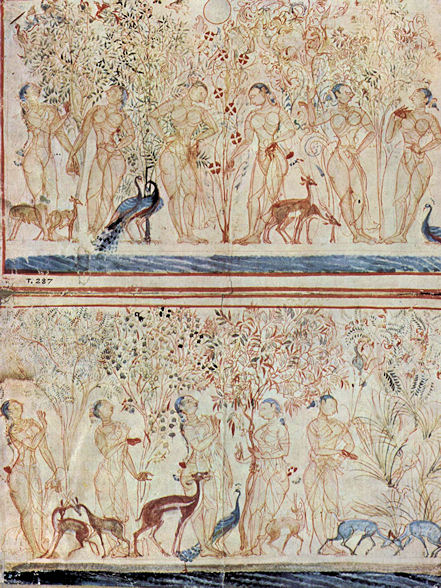
Abb.: गोप्यो यमुनातटे ।
Orissa, um 1550 n. Chr.
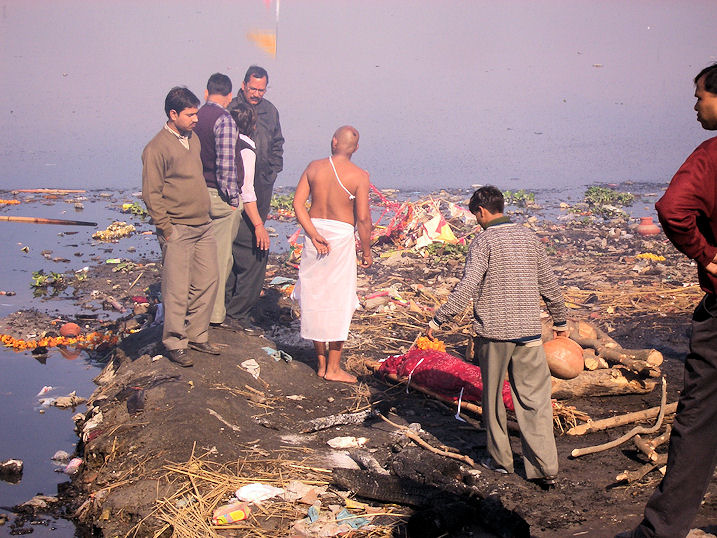
Abb.: Leichenverbrennung an der Yamunā
[Bildquelle:
Giovanni
Cannata. --
http://www.flickr.com/photos/giovanni_cannata/444688412/. -- Zugriff am
2010-09-17. --
Creative
Commons Lizenz (Namensnennung, keine kommerzielle Nutzung, keine
Bearbeitung)]
2 शमनस्वसृ f.: Schwester des Śamana (Yamas)
Yama, der Todesgott, heißt Śamana = Beruhiger, weil er alles zur Ruhe bringt.
32. c./d. revā tu narmadā somodbhavā mekalakanyakā
रेवा तु नर्मदा सोमोद्भवा मेकलकन्यका ॥३२ ख॥
[Bezeichnungen für die Narmadā1 sind:]
रेवा f.: Revā
नर्मदा f.: Narmadā1
सोमोद्भवा f.: aus dem Mond Entstandene
मेकलकन्यका f.: Töchterchen Mekalas
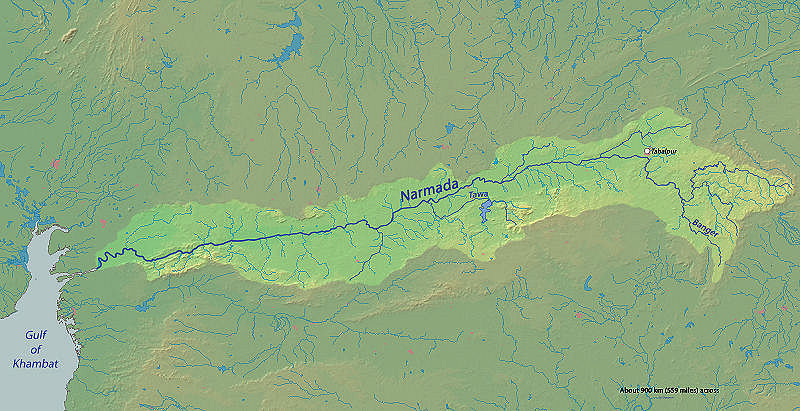
Abb.: नर्मदा ।
[Bildquelle: Shannon / Wikipedia. -- GNU FDLicense]
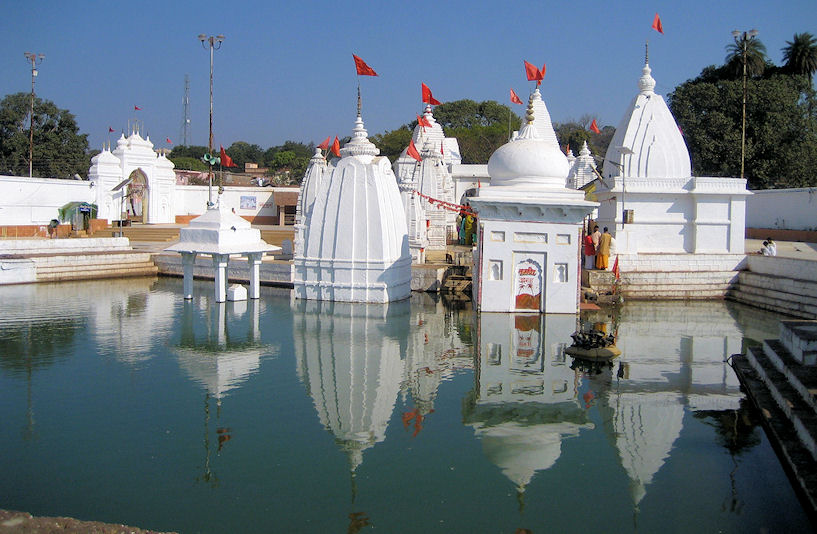
Abb.: Amarkantak - अमरकंटक - der Ursprung der Narmadā
[Bildquelle:
Ajay
Tao. --
http://www.flickr.com/photos/26012570@N02/2458101807/. -- Zugriff am
2010-09-17. --
Creative
Commons Lizenz (Namensnennung, keine kommerzielle Nutzung, share alike)]
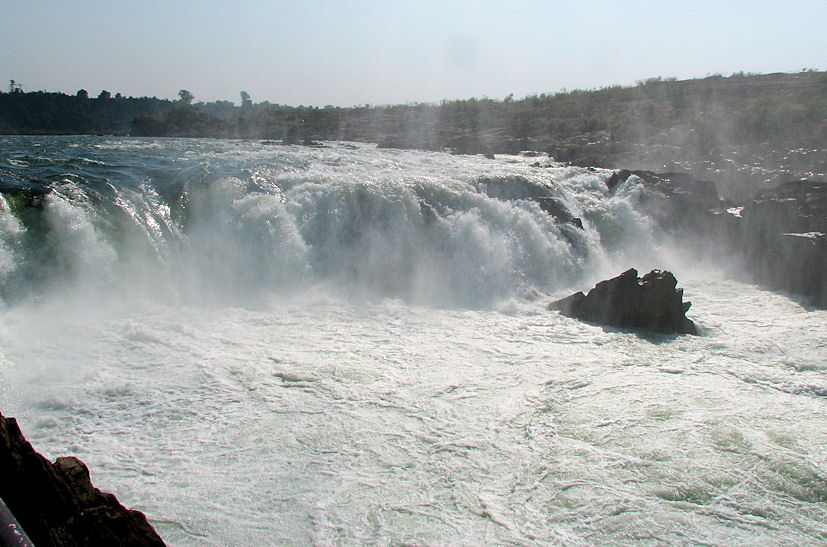
Abb.: Narmadā-Fall bei Bheraghat, M. P.
[Bildquelle: Jeff Daggett. --
http://www.flickr.com/photos/jmdaggett/117535376/. -- Zugriff am 2010-09-17.
-- Creative
Commons Lizenz (Namensnennung, keine kommerzielle Nutzung, share alike)]
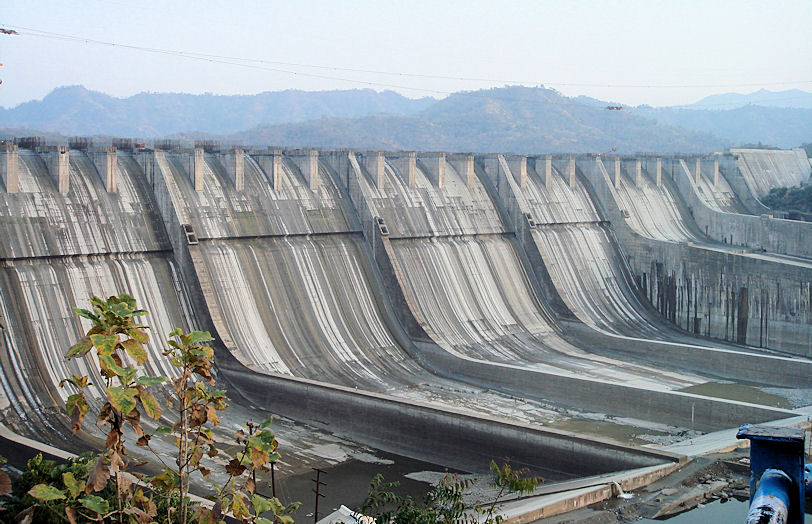
Abb.: Sardar Sarovar Dam - સરદાર સરોવર બંધ der Narmadā, Gujarat,
2006
[Bildquelle: AceFighter19 / Wikimedia. -- Public domain]
http://creativecommons.org/licenses/by-nc-nd/2.0/
Abb.: Narmadā-Mündung bei Bharuch - ભરૂચ, Gujarat
[Bildquelle: ©Google Earth. --
Zugriff am 2010-09-17]
Erläuterungen:
1 नर्मदा f. - Narmadā
"NARMADĀ. The Nerbudda river, which is esteemed holy. The personified river is variously represented as being daughter of a Ṛṣi named Mekala (from whom she is called Mekalā and Mekala-kanyā), as a daughter of the moon, as a mind-born daughter of the Somapas, and as sister of the Nāgas. It was she who brought Purukutsa to the aid of the Nāgas against the Gandharvas, and the grateful snake-gods made her name a charm against the venom of snakes. According to the Viṣṇu Purāṇa, she had a son by Purukutsa who was named Trasadasyu. The Matsya Purāṇa gives Duḥ-saha as the name of her husband. The Hari-vaṃśa is inconsistent with itself. In one place it makes her wife of Purukutsa and mother of Trasadasyu ; in another it makes her the wife of Trasadasyu. She is also called Revā and Pūrva-gaṅgā, and, as a daughter of the moon, Indu-jā and Somodbhavā." [Quelle: Dowson, John <1820-1881>: A classical dictionary of Hindu mythology and religion, geography, history, and literature. -- London, Trübner, 1879. -- s.v.]
"Narbada (Nerbudda, im Sanskrit Narmadá, »die Liebliche«), Fluß in Vorderindien, der als Grenze zwischen Hindostan und dem Dekhan gilt, entspringt in 1005 m Höhe unter 81°49´ östl. L. auf dem Amarkantakplateau, von dem er in 21 m hohem Wasserfall hinabstürzt, um mit vielen Stromschnellen und starkem Gefälle in durchschnittlich westlicher Richtung nach Dschabalpur, dann zwischen den Windhyabergen im Norden, den Mahadeo-, Kalabhat- und Satpuraketten im S. über Hoschangabad, Handia und Madlessar zu fließen und 48 km unterhalb Barotsch, 1280 km lang, in breitem Ästuar in die Bai von Cambay zu münden. Das Gefälle beträgt im Durchschnitt 0,94 m auf das Kilometer; zur Regenzeit schwellen die Wasser oft mächtig an, so daß die Eisenbahnbrücke bei Barotsch wiederholt zerstört worden ist. Reiche Kornfelder liegen auf beiden Ufern, bei Hoschangabad auch ergiebige Eisen- und Kohlenminen. Die N. ist den Hindu fast so heilig wie der Ganges, und ihre Quelle mit Tempeln wird jährlich von zahlreichen Pilgern aufgesucht." [Quelle: Meyers großes Konversations-Lexikon. -- DVD-ROM-Ausg. Faksimile und Volltext der 6. Aufl. 1905-1909. -- Berlin : Directmedia Publ. --2003. -- 1 DVD-ROM. -- (Digitale Bibliothek ; 100). -- ISBN 3-89853-200-3. -- s.v.]
33. a./b. karatoyā sadānīrā bāhudā saitavāhinī
करतोया सदानीरा बहुदा सैतवाहिनी ।३३ क।
[Bezeichnungen für die Karatoyā - করতোয়া নদী - sind:]
करतोया f.: "Wasser von der Hand", Karatoyā1
सदानीरा f.: "immer Wasser Führende", Sadānīrā
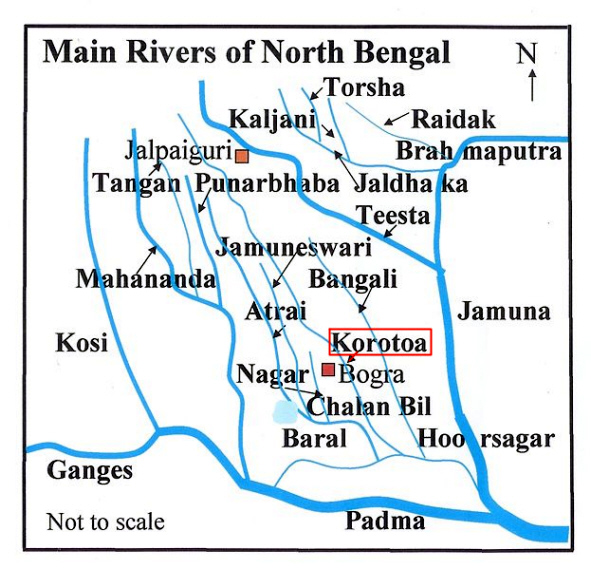
Abb.: करतोया । করতোয়া
[Bildquelle: P.K.Niyogi / Wikipedia. -- GNU
FDLicense]
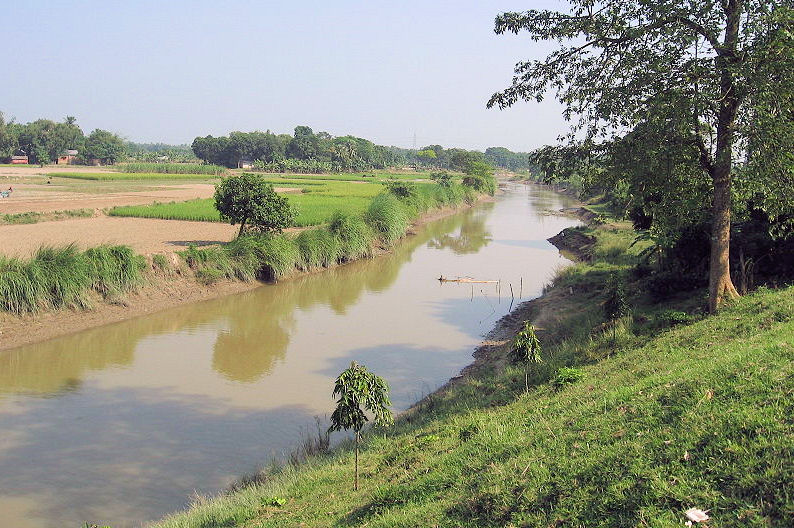
Abb.: करतोया । bei Mahasthangarh -
মহাস্থানগড়,
Bangladesh
[Bildquelle: P.K.Niyogi / Wikipedia. -- Public domain]
Erläuterungen:
1 करतोया f.: "Wasser von der Hand", Karatoyā
So benannt, weil der Fluss vom Wasser (der Vertragsschließung) stammen soll, das über die Hand Śivas gegossen wurde, als er Pārvatī heiratete.
33. a./b. karatoyā sadānīrā bāhudā saitavāhinī
करतोया सदानीरा बहुदा सैतवाहिनी ।३३ क।
[Bezeichnungen für die Bahudā sind:]
बहुदा f.: Bahudā1
सैतवाहिनी f.:
Erläuterungen:
1 बहुदा f.: Bahudā
"Bahuda originates from the Ramgiri hills in Gajapati District [ଗଜପତି, Orissa]. It then passes through Ganjam District [ଗଂଜାମ] and enters Srikakulam District [శ్రీకాకుళం] in Andhra Pradesh, where it drains into the Bay of Bengal. The river is 73 km long and has a catchment area of 1250 sq km. " [Quelle: http://www.india9.com/i9show/Bahuda-River-24132.htm. -- Zugriff am 2010-09-17]
"The legend behind Bahuda River Long ago there lived two brothers Śaṅkha and Likhita. They were on a pilgrimage to Kanipakam (కాణిపాకం). As the journey was tiring, the younger brother Likhita felt hungry. Disregarding the advice of the elder brother he plucked a mango from the mango grove. Śaṅkha felt bad and reported this to the ruler of that area and pleaded for punishment for the sin committed during the pilgrimage. Thus Likhita was punished severely being deprived of both arms.
Later, they bathed in the river near Kanipakam temple. Lo Behold! The chopped arms were restored to Likhita as soon as he had a dip in the sacred waters of the river. These incidents lead the ruler to rename the river as Bahu- dā (Bahu - बहु - means human arm). Thus the river beside Kanipakam temple is now known as 'Bahudā River'."
[Quelle: http://en.wikipedia.org/wiki/Kanipakam. -- Zugriff am 2010-09-17]
33. c./d. śatadrus tu śutudriḥ syād vipāśā tu vipāṭ striyām
शतद्रुस् तु शुतुद्रिः स्यद् विपाशा तु विपाट् स्त्रियाम् ॥३३ ख॥
[Bezeichnungen für die Śatadru = Sutlej River1 = ਸਤਲੁਜ = ستلج - sind:]
शतद्रु f.: "100 Läufe habend", Śatadru
शुतुद्रि f.: Śutudri
[Bezeichnungen für die Vipāś = Beas River2 = ब्यास = ਬਿਆਸ = بیاس - sind:]
विपाशा f.: "Ungezügelte", Vipāśā
विपाश् f.: "Ungezügelte", Vipāś
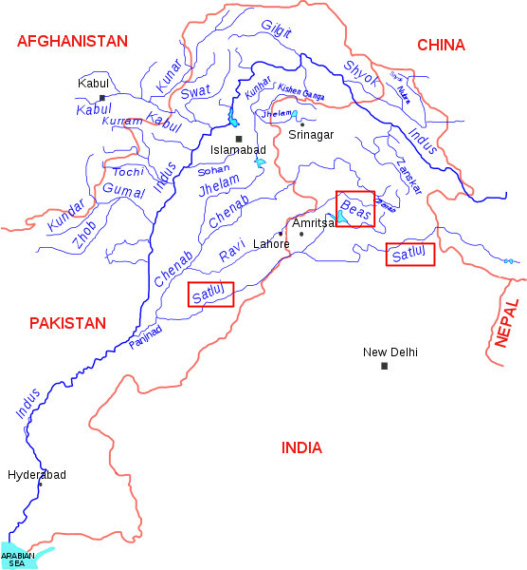
Abb.: शतद्रुर्विपाशा च । Sutlej und Beas -
ستلج ,بیاس
[Bildquelle: Kmhkmh / Wikipedia. --
Creative Commons
Lizenz (Namensnennung)]
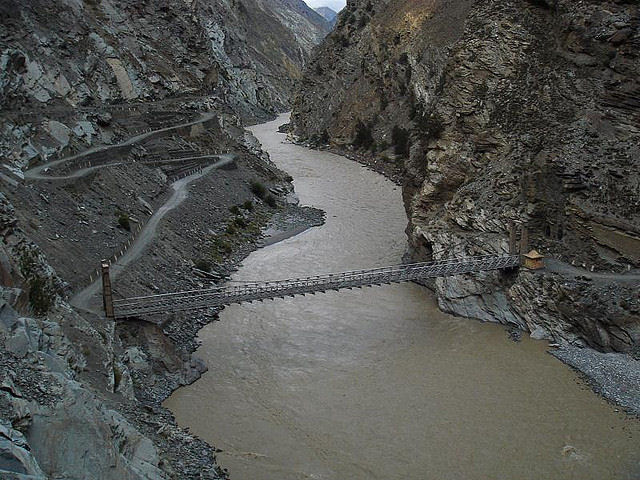
Abb.: शतद्रुः = Sutlej River =
ਸਤਲੁਜ = ستلج
[Bildquelle:
Robin Browne. --
http://www.flickr.com/photos/engti/2766866877/. -- Zugriff am 2010-09-17. --
Creative
Commons Lizenz (Namensnennung, keine kommerzielle Nutzung, share alike)]
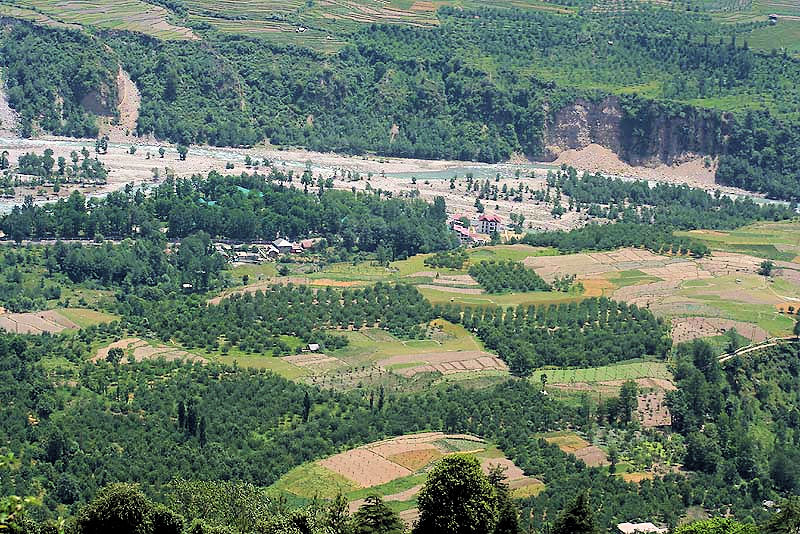
Abb.: Vipāś = Beas
River2 = ब्यास
= ਬਿਆਸ =
بیاس
Kullu District, Himachal Pradesh
[Bildquelle: J. M. Garg / Wikipedia. -- GNU FDLicense]
1 Śatadru = Sutlej River
| Satluj | |
| Daten | |
|---|---|
| Lage | VR China (Tibet), Indien (Himachal Pradesh, Punjab), Pakistan (Punjab) |
| Quellsee | Rakshastal 30° 50′ 39″ N, 81° 12′ 17″ O30.84417360722581.204586029053 |
| Zusammenfluss | mit dem Chanab zum Panjnad
29.34926216159271.028156280518
Koordinaten:
29° 20′ 57″ N,
71° 1′ 41″ O
29° 20′ 57″ N, 71° 1′ 41″ O29.34926216159271.028156280518 |
| Länge | 1.450 km |
| Rechte Nebenflüsse | Beas |
[Quelle der Tabelle:
http://de.wikipedia.org/wiki/Satluj. -- Zugriff am 2010-09-17]
"Satledsch (engl. Sutlej, im Sanskrit Satadru, tibetisch Langtschan, der Zaradros des Ptolemäos, der Hyphasis und Hesydros des Plinius), größter und östlichster der fünf Ströme des Pandschab, entspringt im südlichen Tibet unter 31° nördl. Br. und 81°35´ östl. L., unweit der Quellen des Brahmaputra und Indus in den Kailasbergen, durchfließt die Seen ð Manassarowar (s. d.) und Rakas Tal (4660 m ü. M.), verfolgt als Langtschankampo nordwestliche, nach dem Durchbruch durch den Himalaja, wobei er den von NW. kommenden Spiti aufnimmt, südwestliche Richtung, tritt dann in die Ebene, nimmt rechts den Bias auf und wird nun auch Gara genannt. Nach Vereinigung mit dem Tschinab heißt er Pandschnad und fällt, 1500 km lang, bei Mithankot in den Indus. Er ist bei Hochwasser bis Firozpur schiffbar." [Quelle: Meyers großes Konversations-Lexikon. -- DVD-ROM-Ausg. Faksimile und Volltext der 6. Aufl. 1905-1909. -- Berlin : Directmedia Publ. --2003. -- 1 DVD-ROM. -- (Digitale Bibliothek ; 100). -- ISBN 3-89853-200-3. -- s.v.]
"ŚATA-DRU. 'Flowing in a hundred (channels)'. The name of the river Sutlej, the Zaradrus of Ptolemy, the Hesudrus of Pliny." [Quelle: Dowson, John <1820-1881>: A classical dictionary of Hindu mythology and religion, geography, history, and literature. -- London, Trübner, 1879. -- s.v.]
2 Vipāś = Beas River
| Beas | |
| Daten | |
|---|---|
| Lage | Himachal Pradesh und Punjab, Indien |
| Flusssystem | Indus |
| Quelle | beim Rohtang-Pass |
| Mündung | bei Harike (südlich Amritsar) in den Satluj
31.15222165441174.971475601196
Koordinaten:
31° 9′ 8″ N,
74° 58′ 17″ O
31° 9′ 8″ N, 74° 58′ 17″ O31.15222165441174.971475601196 |
| Länge | 470 km |
[Quelle der Tabelle: http://de.wikipedia.org/wiki/Beas_%28Fluss%29. -- Zugriff am 2010-09-17]
"VIPĀŚ, VIPĀŚĀ. The river Byās, the Hyphasis or Bibasis of the classical writers. A legend relates that it obtained its name through the sage Vasiṣṭha, who, wishing to commit suicide, bound his limbs with cords and threw himself into the water. The river, declining to drown him, cast him unbound (vipāśa) on its bank." [Quelle: Dowson, John <1820-1881>: A classical dictionary of Hindu mythology and religion, geography, history, and literature. -- London, Trübner, 1879. -- s.v.]
34. a./b. śoṇo hiraṇyavāhaḥ syāt kulyālpā kṛtrimā sarit
शोणो हिरण्यवाहः स्यात् कुल्याल्पा कृत्रिमा सरित् ।३४ क।
[Bezeichnungen für den Śoṇa = Son river = सोन नदी1 - sind:]
शोण m.: "Roter", Śoṇa
हिरण्यवाह m.: Goldbringer
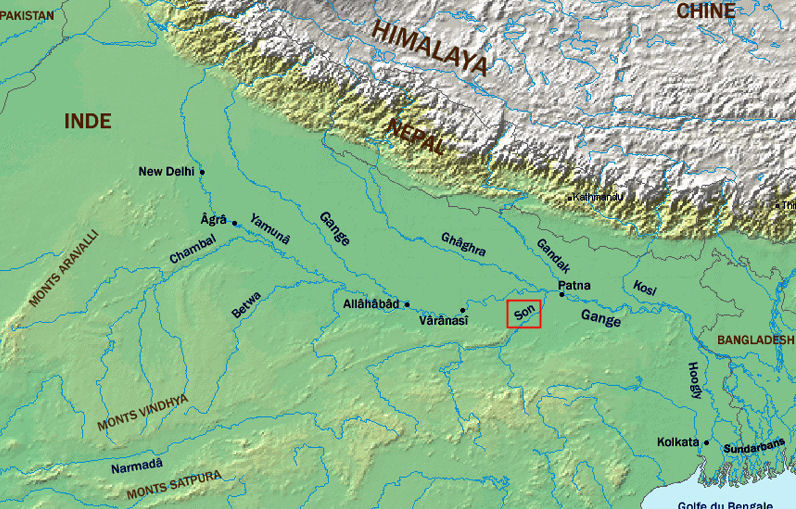
Abb.: शोणः ।
[Bildquelle: Nataraja / Wikipedia. -- GNU FDLicense]
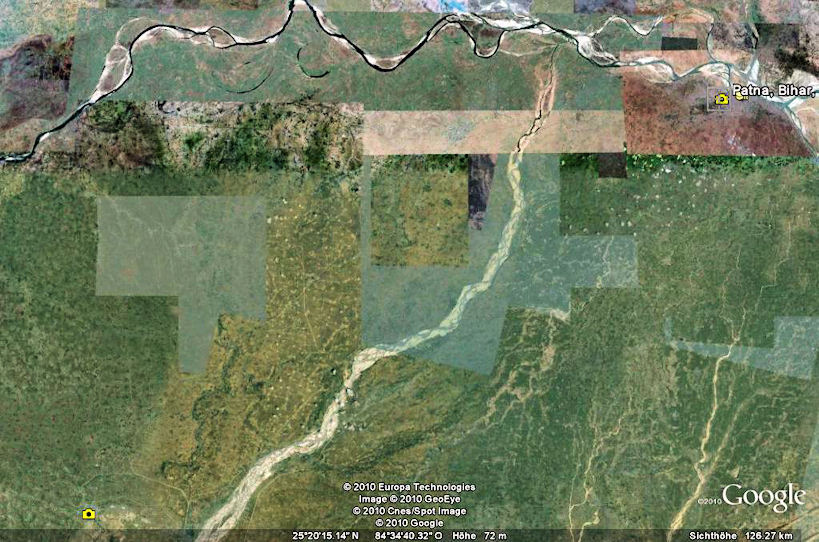
Abb.: शोणः । bei Patna -
पटना
[Bildquelle: ©Google Earth. -- Zugriff am 2010-09-17]
Erläuterungen:
1 शोण m. = Son river = सोन नदी
| Sone River (Saun) | |
| Savan | |
| River | |
| Country | India |
|---|---|
| States | Madhya Pradesh, Jhakhrand, Uttar Pradesh, Bihar |
| Region | Baghelkhand |
| Tributaries | |
| - left | Ghaghar River |
| - right | Banas River, Gopad River, Rihand River, Kanhar River, North Koel River |
| Cities | Sidhi, Dehri, Patna |
| Landmark | Indrapuri Barrage |
| Source | Amarkantak |
| - elevation | 600 m (1,969 ft) |
| Mouth | Ganga River |
| - coordinates | 25°42′9″N 84°51′54″E / 25.7025°N 84.865°E |
| Length | 784 km (487 mi) |
[Quelle der Tabelle:
http://en.wikipedia.org/wiki/Son_river. -- Zugriff am 2010-09-17]
"Son (Sone, Soane, Schon), rechter Nebenfluss des Ganges, entspringt in Zentralindien am Gebirge Amarkantak und mündet, 748 km lang, oberhalb Patna. Der Unterlauf ist schiffbar und durch Kanäle mit dem Ganges verbunden." [Quelle: Meyers großes Konversations-Lexikon. -- DVD-ROM-Ausg. Faksimile und Volltext der 6. Aufl. 1905-1909. -- Berlin : Directmedia Publ. --2003. -- 1 DVD-ROM. -- (Digitale Bibliothek ; 100). -- ISBN 3-89853-200-3. -- s.v.]
34. a./b. śoṇo hiraṇyavāhaḥ syāt kulyālpā kṛtrimā sarit
शोणो हिरण्यवाहः स्यात् कुल्याल्पा कृत्रिमा सरित् ।३४ क।
Einen kleiner bzw. künstlichen Fluss nennt man कुल्या f.: Bach, (Bewässerungs-)Kanal
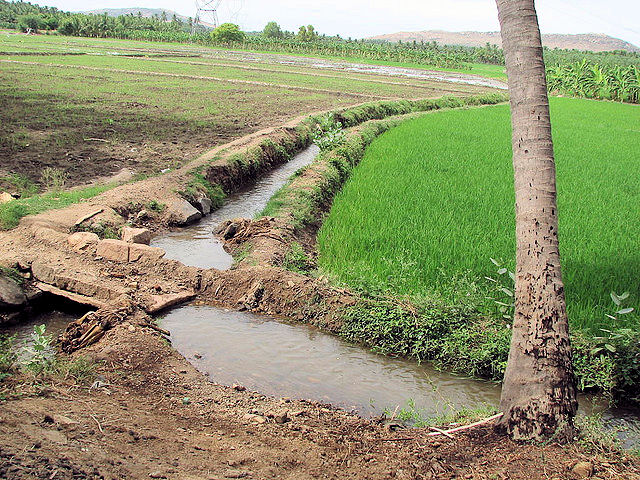
Abb.: कुल्या, Tamil Nadu
[Bildquelle:
Pari. --
http://www.flickr.com/photos/88585285@N00/208639541/. -- Zugriff am
2010-09-17. --
Creative
Commons Lizenz (Namensnennung, keine kommerzielle Nutzung, keine
Bearbeitung)]
34 c./d. śarāvatī vetravatī
candrabhāgā sarasvatī
35. a./b. kāverī sarito 'nyāś ca sambhedaḥ sindhusaṅgamaḥ
शरावती वेत्रवती चन्द्रभागा सरस्वती
॥३४ ख॥
कावेरी सरितो
ऽन्याश् च सम्भेदः सिन्धुसङ्गमः ।३५ क।
Weitere Flüsse sind:
शरावती f.: Śarāvatī1 - Sharavati river - ಶರಾವತಿ ನದಿ
वेत्रवती f.: Vetravatī2 - Betwa river - बेतवा नदी
चन्द्रभागा f.: Candrabhāgā3 - Chenab River - ਚਨਾਬ - چناب,
सरस्वती f.: Sarasvatī4
कावेरी f.: Kāverī5
und andere
Erläuterungen
1 शरावती f.: Śarāvatī - Sharavati river - ಶರಾವತಿ ನದಿ
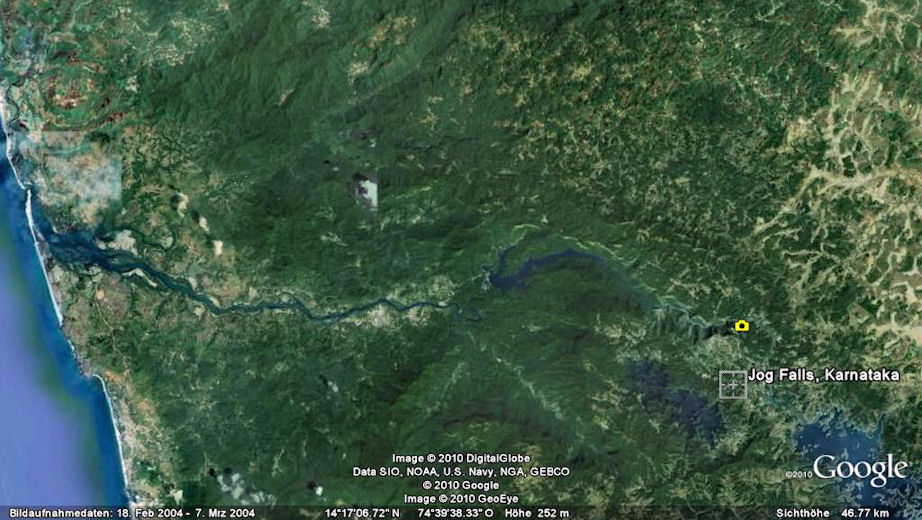
Abb.: शरावती -
Sharavati river -
ಶರಾವತಿ ನದಿ
[Bildquelle: ©Google Earth. --
Zugriff am 2010-09-17]
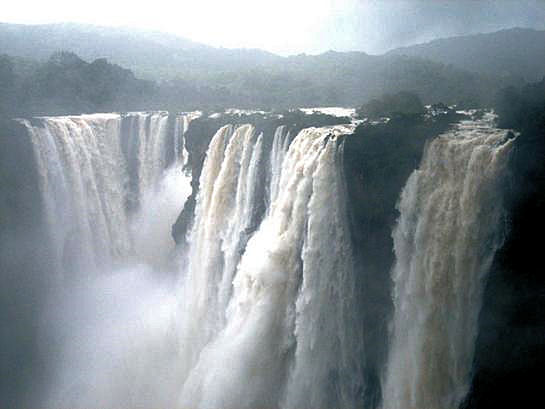
Abb.: शरावती । Jog falls - ಜೋಗ
ಜಲಪಾತ
[Bildquelle: Kiran Sagara / Wikipedia. --
Public domain]
"Sharavathi River (Kannada: ಶರಾವತಿ ನದಿ) is a river which originates and flows entirely within the state of Karnataka in India. It is one of the few westward flowing rivers of India and a major part of the river basin lies in the Western Ghats. The famous Jog Falls are formed by this river. The river itself and the region around it are rich in biodiversity and are home to many rare species of flora and fauna." [Quelle: http://en.wikipedia.org/wiki/Sharavati. -- Zugriff am 2010-09-17]
2 वेत्रवती f.: Vetravatī - Betwa river - बेतवा नदी
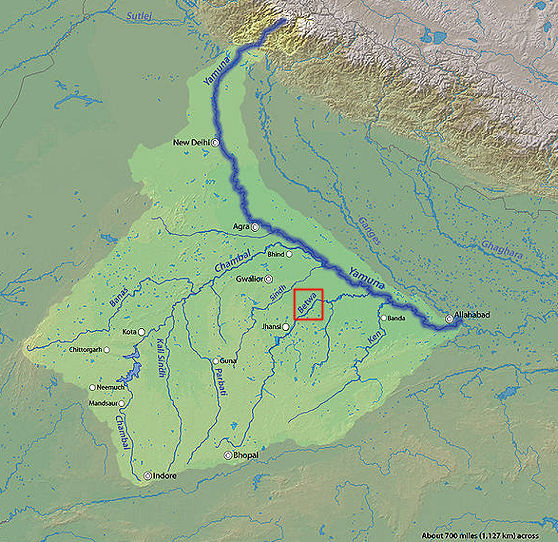
Abb.: वेत्रवती -
Betwa river - बेतवा नदी
[Bildquelle: Shannon / Wikipedia. -- GNU FDLicense]
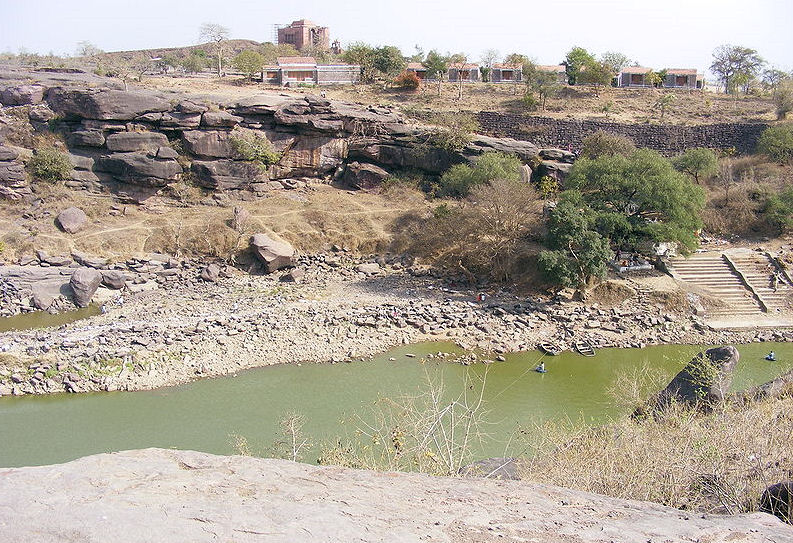
Abb.: वेत्रवती -
Betwa river - बेतवा नदी, bei Bhojpur
[Bildquelle: Amit Solanki / Wikipedia. --
Creative Commons
Lizenz (Namensnennung)]
"VETRAVATĪ. The river Betwa, which rises in the Vindhyas and falls into the Jumna below Kalpi."
[Quelle: Dowson, John <1820-1881>: A classical dictionary of Hindu mythology and religion, geography, history, and literature. -- London, Trübner, 1879. -- s.v.]
""The Betwa is a river in Northern India, and a tributary of the Yamuna. Also known as the Vetravati, the Betwa rises in the Vindhya Range just north of Hoshangabad [होशंगाबाद] in Madhya Pradesh and flows north-east through Madhya Pradesh and flow through Orchha [ओरछा] to Uttar Pradesh. Nearly one-half of its course, which is not navigable, runs over the Malwa Plateau before it breaks into the upland. A tributary of the Yamuna River, the confluence of the Betwa and the Yamuna Rivers takes place in the Hamirpur [हमीरपुर] town in Uttar Pradesh, in the vicinity of Orchha." [Quelle: http://en.wikipedia.org/wiki/Betwa. -- Zugriff am 2010-09-17]
3 चन्द्रभागा f.: Candrabhāgā - Chenab River - ਚਨਾਬ - چناب,
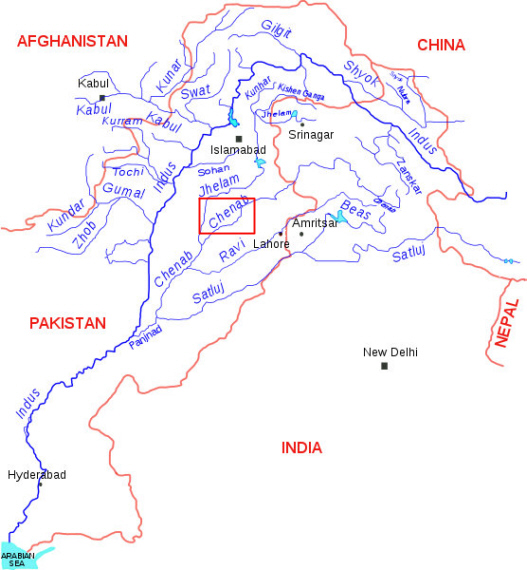
Abb.: चन्द्रभागा । Chenab -
چناب
[Bildquelle: Kmhkmh / Wikipedia. --
Creative Commons
Lizenz (Namensnennung)]
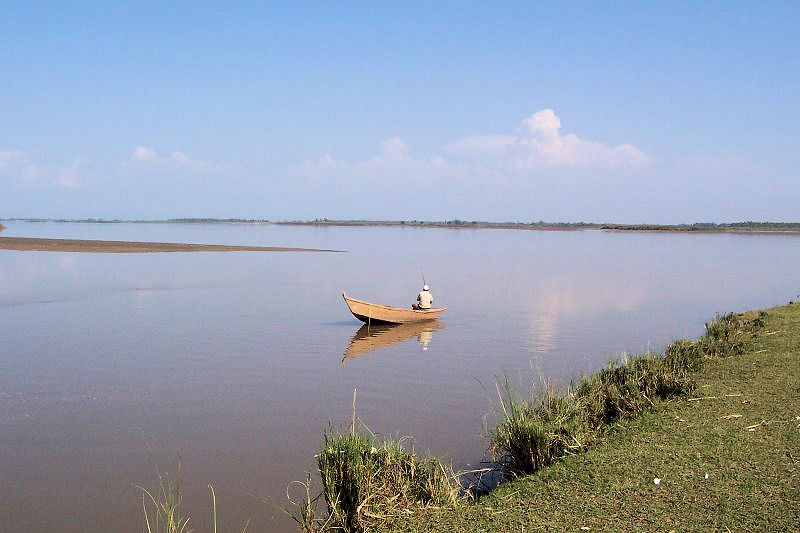
Abb.: चन्द्रभागा । Chenab -
چناب bei Sialkot -
سیالکوٹ, Pakistan
[Bildquelle: Yaminjanjua / Wikipedia. -- Public domain]
"Tschenab (Tschinab, der Akassines der Alten), einer der fünf Ströme des Pandschab, die dem Indus zufließen, entspringt in Kaschmir, nimmt in der Ebene den Dschelam, später den Rawi auf und vereinigt sich unterhalb Bahawalpur mit dem Satledsch zum Pandschnad." [Quelle: Meyers großes Konversations-Lexikon. -- DVD-ROM-Ausg. Faksimile und Volltext der 6. Aufl. 1905-1909. -- Berlin : Directmedia Publ. --2003. -- 1 DVD-ROM. -- (Digitale Bibliothek ; 100). -- ISBN 3-89853-200-3. -- s.v.]
4 सरस्वती f.: Sarasvatī
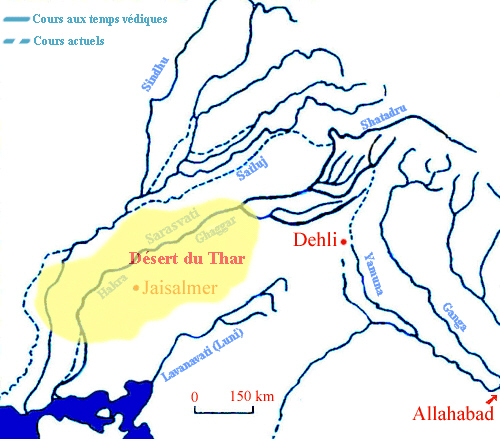
Abb.: सरस्वती ।
[Bildquelle: Nataraja / Wikipedia. -- GNU FDLicense]
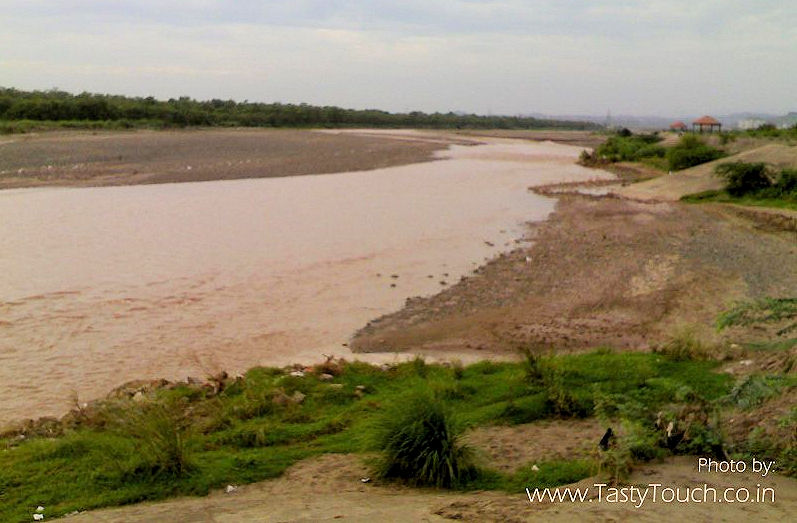
Abb.: सरस्वती = Ghaggar-Hakra River
[Bildquelle: Maheshkumaryadav / Wikipedia. --
Creative Commons
Lizenz (Namensnennung)]
"SARASVATĪ. 'Watery, elegant'. In the Vedas, Sarasvatī is primarily a river, but is celebrated in the hymns both as a river and a deity. The Sarasvatī river was one boundary of Brahmāvartta, the home of the early Āryans, and was to them, in all likelihood, a sacred river, as the Ganges has long been to their descendants.
[...]
The river is now called Sarsuti. It falls from the Himalayas and is lost in the sands of the desert. In ancient times it flowed on to the sea.
A passage in the Ṛg-veda says of it, "She who goes on pure from the mountains as far as the sea." Max Müller, Veda, 45.
According to the Mahā-bhārata it was dried up by the curse of the sage Utathya (q.v.). See Sapta-sindhava."[Quelle: Dowson, John <1820-1881>: A classical dictionary of Hindu mythology and religion, geography, history, and literature. -- London, Trübner, 1879. -- s.v.]
5 कावेरी f.: Kāverī = Kaveri river = ಕಾವೇರಿ = காவிரி
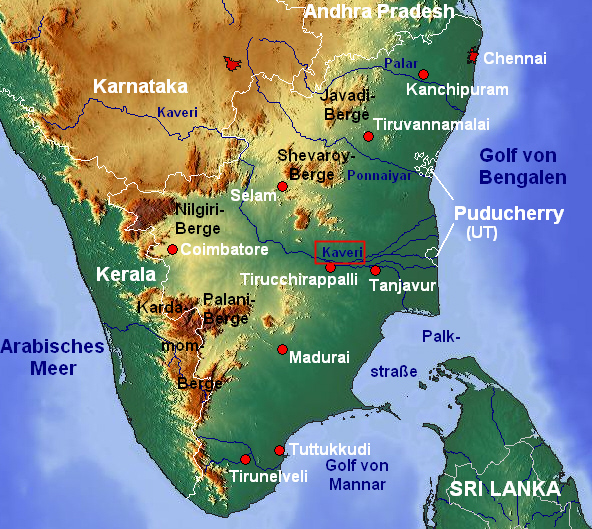
Abb.: कवेरी । ಕಾವೇರಿ - காவிரி
[Bildquelle: Jungpionier / Wikipedia.
-- Creative
Commons Lizenz (Namensnennung, share alike)]
"Kawéri (engl. Cauvery), Fluß in der britisch- ind. Präsidentschaft Madras, 760 km lang, entspringt auf den Westghats in Kurg, durchfließt Maisur, durchbricht bei Kaweripura die Ostghats, bildet, 145 km vom Meer, von Trichinopoli an ein 145 km breites Delta, den »Garten von Indien«, und mündet in den Bengalischen Meerbusen. Befahren wird er nur von kleinen geflochtenen Booten. Die Hindu halten ihn als Dakschin Ganga (»Ganges des Südens«) heilig." [Quelle: Meyers großes Konversations-Lexikon. -- DVD-ROM-Ausg. Faksimile und Volltext der 6. Aufl. 1905-1909. -- Berlin : Directmedia Publ. --2003. -- 1 DVD-ROM. -- (Digitale Bibliothek ; 100). -- ISBN 3-89853-200-3. -- s.v.]
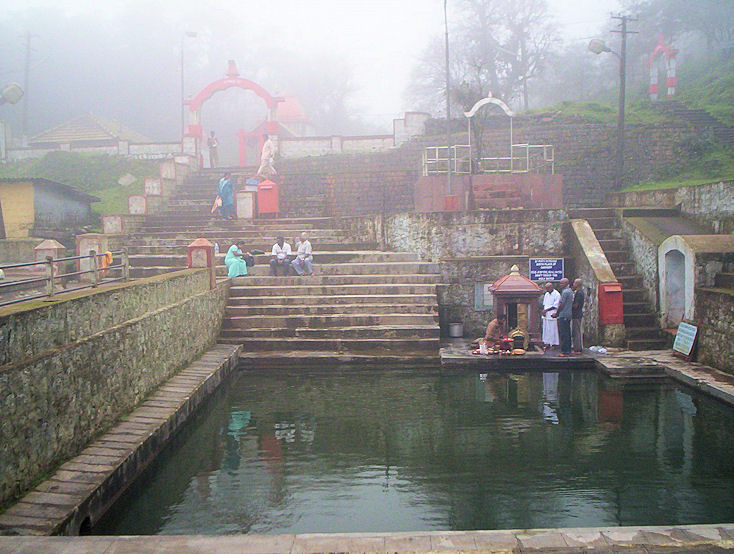
Abb.: Talakaveri -
ತಲಕಾವೇರಿ (Quelle des Kaveri river),
Karnataka, India
[Bildquelle: Abhijitsathe / Wikipedia. --
Creative Commons
Lizenz (Namensnennung)]
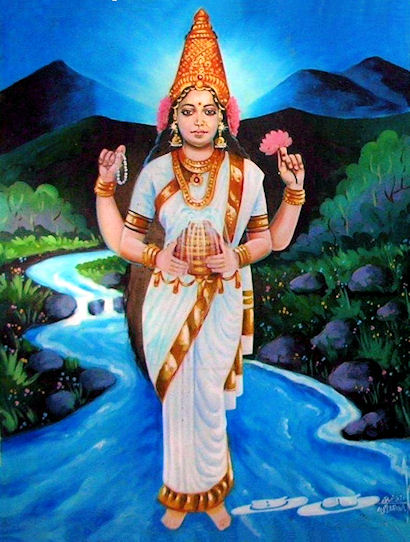
Abb.: कावेरीदेवी ।
[Bildquelle: Wikipedia. -- Public domain]
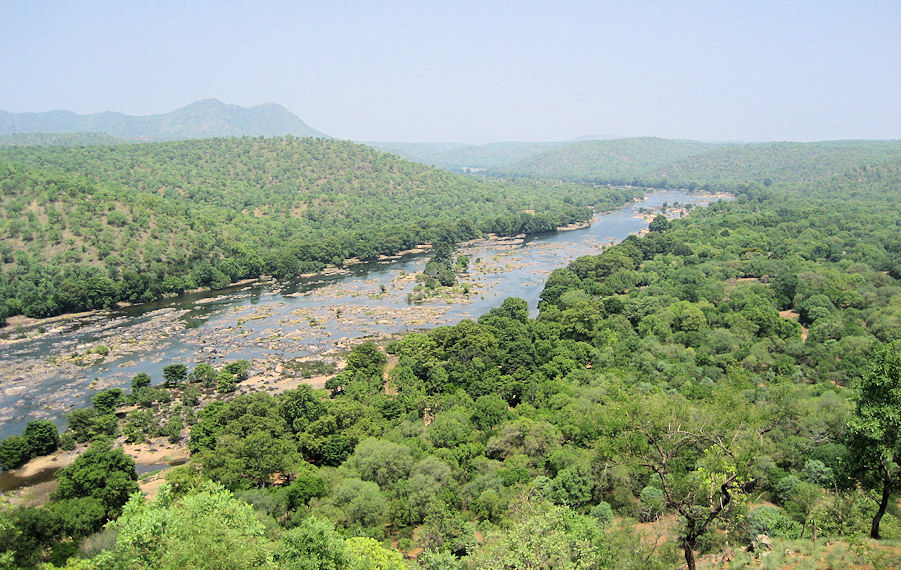
Abb.: कवेरी । ಕಾವೇರಿ - காவிரி
[Bildquelle:
Mohan N. --
http://www.flickr.com/photos/mohanbn/3509728024/. -- Zugriff am 2010-09-17.
-- Creative
Commons Lizenz (Namensnennung, keine kommerzielle Nutzung)]
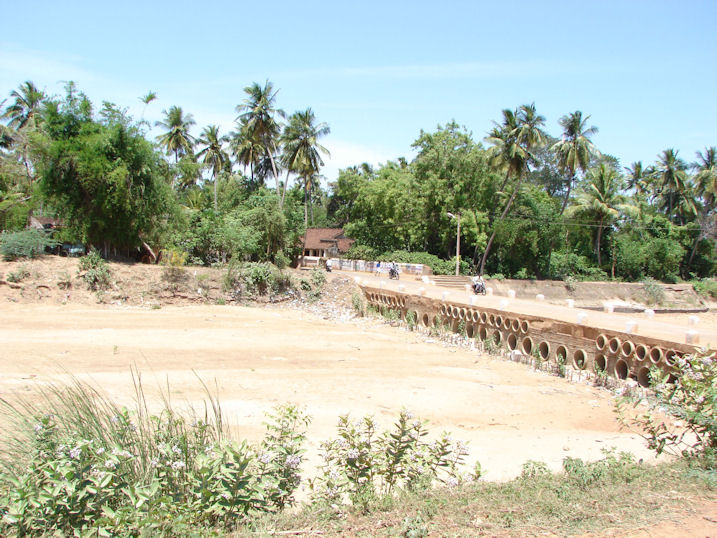
Abb.: Ausgetrocknetes Flussbett der कवेरी - ಕಾವೇರಿ - காவிரி
[Bildquelle:
Harini Calamur. --
http://www.flickr.com/photos/gargi/167046858/. -- Zugriff am 2010-09-17. --
Creative
Commons Lizenz (Namensnennung, keine kommerzielle Nutzung, keine
Bearbeitung)]
35. a./b. kāverī sarito 'nyāś ca sambhedaḥ sindhusaṅgamaḥ
कावेरी सरितो ऽन्याश् च सम्भेदः सिन्धुसङ्गमः ।३५ क।
[Bezeichnungen für Zusammenfluss sind:]
सम्भेद m.: Vereinigung, Zusammenfluss
सिन्धुसङ्गम m.: Zusammenfluss von Flüssen
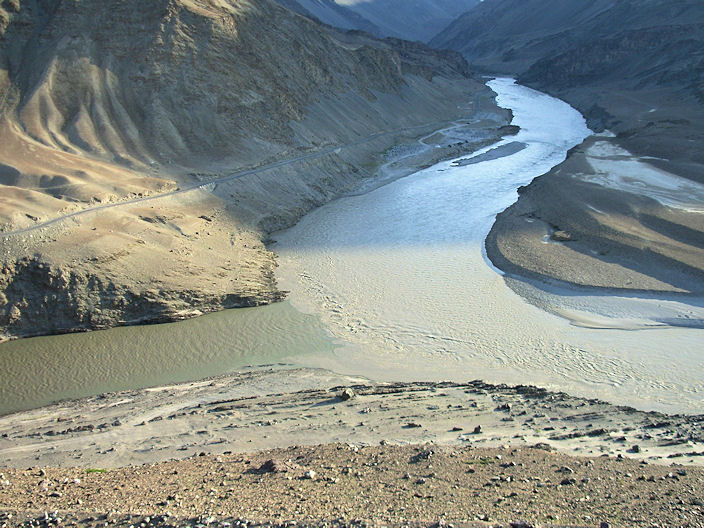
Abb.: ज़ांस्करसिन्धुसंगमः । Zusammenfluss des Zanskar river und
Indus, bei Nimmu, Ladakh
[Bildquelle:
Madhav Pai. --
http://www.flickr.com/photos/madpai/244779668/. -- Zugriff am 2010-09-18. --
Creative Commons
Lizenz (Namensnennung)]
35. c./d. dvayoḥ praṇālī payasaḥ padavyāṃ triṣu tūttarau
द्वयोः प्रणाली पयसः पदव्यां त्रिषु टुत्तरौ
॥३५ ख॥
Eine Weg für Wasser heißt प्रणाली f., m.: Abzugsgraben
35. c./d. dvayoḥ praṇālī payasaḥ padavyāṃ
triṣu tūttarau
36. a./b. devikāyāṃ sarayvāṃ ca bhave dāvikasāravau
द्वयोः प्रणाली पयसः पदव्यां
त्रिषु टुत्तरौ ॥३५ ख॥
देविकायां सरव्यां च भवे दाविकसारवौ ।३६ क।
Adjektive in der Bedeutung vom Fluss Deva (bzw. Devikā) bzw. Sarayu2 herkommend sind दाविक 3: vom Fluss Deva herkommenbd bzw. सारव 3: vom Fluss Sarayu herkommend.1
Erläuterungen:
1 In diesen beiden Fällen ist die Adjektivbildung unregelmäßig
2 Sarayu heute vermutlich = घाघरा
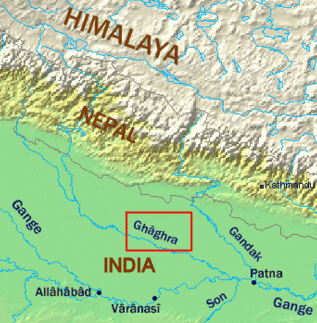
Abb.: सरयुः । घाघरा
[Bildquelle: Thaddeus P. Bejnar / Wikipedia. -- GNU FDLicense]
36. c./d. saugandhikaṃ tu kalhāraṃ hallakaṃ raktasandhyakam
सौगन्धिकं तु कल्हारं हल्लकं रक्तसन्ध्यकम् ॥३६ ख॥
[Bezeichnungen für Nymphaea rubra L. - Red water lily1 sind:]
सौगन्धिक n.: Wohlriechende
कल्हार n.: Kalhāra
हल्लक n.: Hallaka
रक्तसन्ध्यक n.: rotes Sandhyaka
1 Nymphaea rubra L. - Red water lily
Ist die rote Varietät von Nymphaea pubescens Willd.
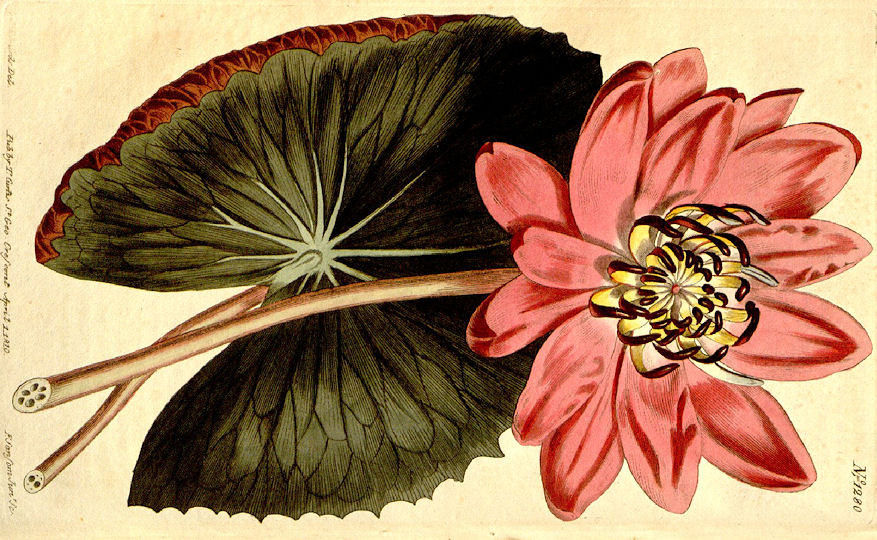
Abb.: रक्तसन्ध्यकम् ।
Nymphaea rubra L. - Red water lily
[Bildquelle: Curtis's Botanical Magazine, v. 31 (1810), Tab. 1280]
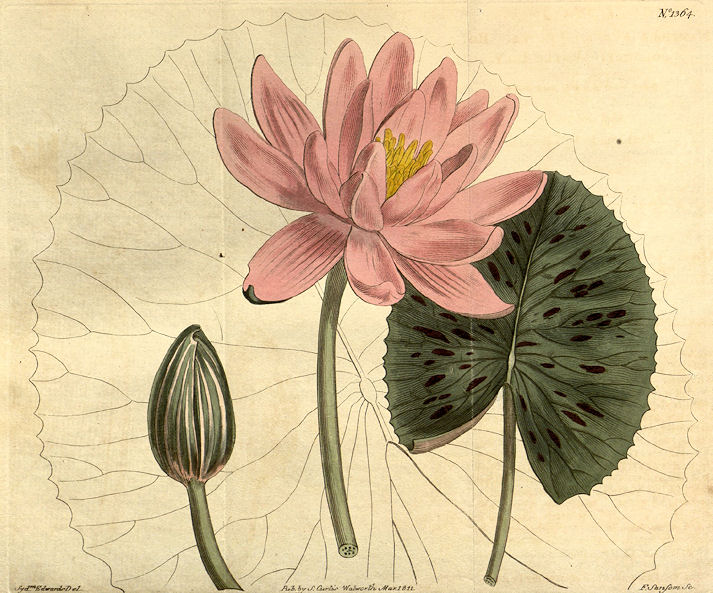
Abb.: रक्तसन्ध्यकम् ।
Nymphaea rubra L. - Red water lily
[Bildquelle: Curtis's Botanical Magazine, v. 33 (1811), Tab. 1364]
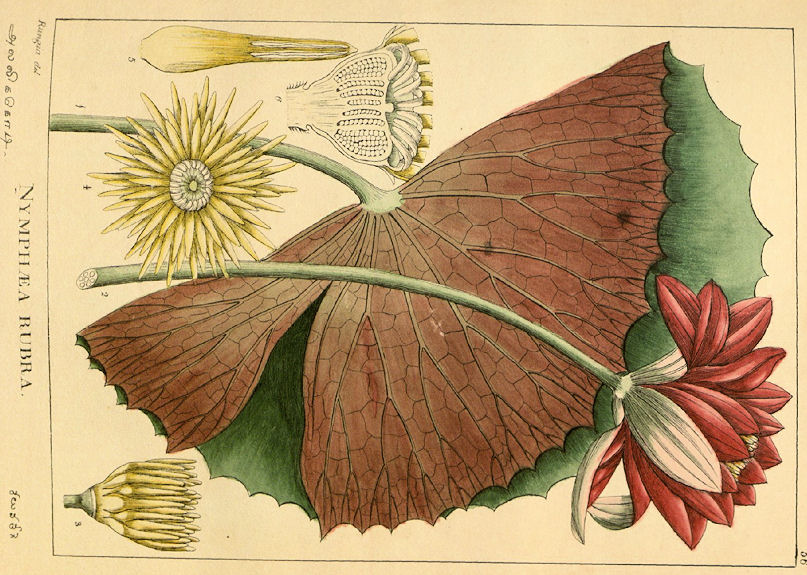
Abb.: रक्तसन्ध्यकम् ।
Nymphaea rubra L. - Red water lily
[Bildquelle: Wight: Illustrations I, Tab. 10,
1840]
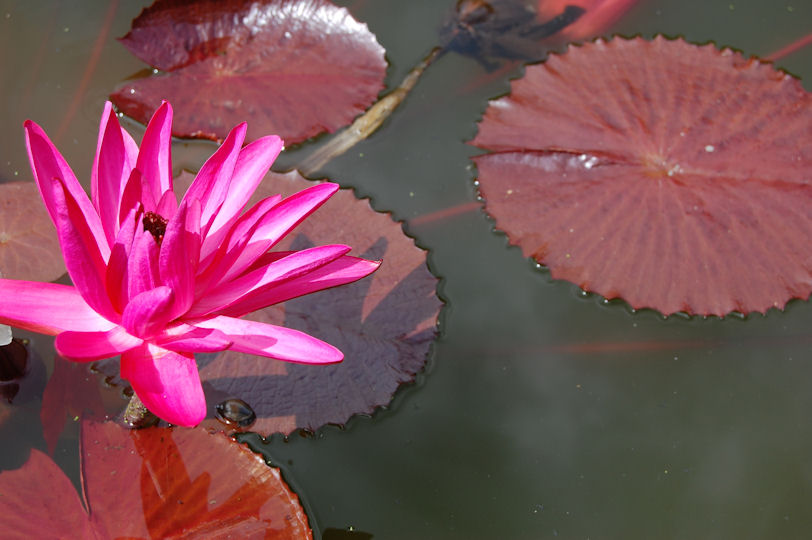
Abb.: रक्तसन्ध्यकम् ।
Nymphaea rubra L. - Red water lily
[Bildquelle: RI / Wikipedia. -- GNU FDLicense]
Erläuterungen:
"Nymphea rubra. Roxb.
[...]
Sans. Hulluka, and Rukta Sundhyuka. See Asiat. Res. vol. 4. p. 285.
[...]
A native of India. It flowers during the rainy season. In Bengal there is a small rose-coloured variety with from twenty to twenty-five stamina, and from twelve to fifteen rays in the stigma, consequently the same number of cells in the capsule. In all other respects they agree. It is by no means so common as Lotus but infinitely more gaudy."
[Quelle: Roxburgh, William <1751-1815>: Flora indica, or, Descriptions of Indian plants / by the late William Roxburgh. -- Serampore : Printed for W. Thacker, 1832. -- Vol. 2, S. 576f.]
"Nymphaea rubra (Roxb.) Red-flowered Water-Lily
[...]
Description.—Aquatic [...]
Fl. March—Aug.
W. & A. Prod. i. 17.—Wight Ill. i. 10.—Roxb. Fl. Ind. ii. 576.
Peninsula in tanks and ditches.
Tanjore.
Economic Uses.—The roots and seeds are eaten by the natives; and the capsules and seeds together are prepared in different ways, sometimes pickled, or put into curries, or made into cakes. A kind of starch and arrowroot is made from the underground stems and roots, and both are used as aliments as well as in medicine. In Bengal there is a small rose-coloured variety with fewer stamens. This is a beautiful flower, yet neither common nor so gaudy as the Egyptian Lotus.—Roxb."
[Quelle: Drury, Heber <1819 - 1872>: The useful plants of India : with notices of their chief value in commerce, medicine, and the arts. -- 2d ed. with additions and corrections. London : Allen, 1873. -- xvi, 512 p. ; 22 cm. -- s.v.]
37. a./b. syād utpalaṃ kuvalayam atha nīlāmbujanma ca
स्याद् उत्पलम् कुवलयम् अथ नीलाम्बुजन्म च ॥३७ क॥
[Bezeichnungen für Nymphaea spp. - Water lily - Seerose - sind:]
उत्पल n.: Seerose, blaue Seerose
कुवलय n.: Seerose, blaue Seerose
37. syād utpalaṃ kuvalayam
atha nīlāmbujanma ca
indīvaraṃ ca nīle 'smin site kumuda-kairave
स्याद् उत्पलम् कुवलयम् अथ नीलाम्बुजन्म च ।
इन्दीवरं च नीले
ऽस्मिन् सिते कुमुद-कैरवे ॥३७॥
[Bezeichnungen für blauen Lotus (Nymphaea caerula Savigny - blue Egyptian lotus - blauer ägyptischer Lotus1 und Nymphaea nouchalii Burm. f. - blue lotus - Stern-Seerose2) sind:]
नीलाम्बुजन्मन् n.: blauer Lotus, blaue Seerose
इन्दीवर n.: blauer Lotus, blaue Seerose
Erläuterungen:
1 Nymphaea caerula Savigny - blue Egyptian lotus - blauer ägyptischer Lotus
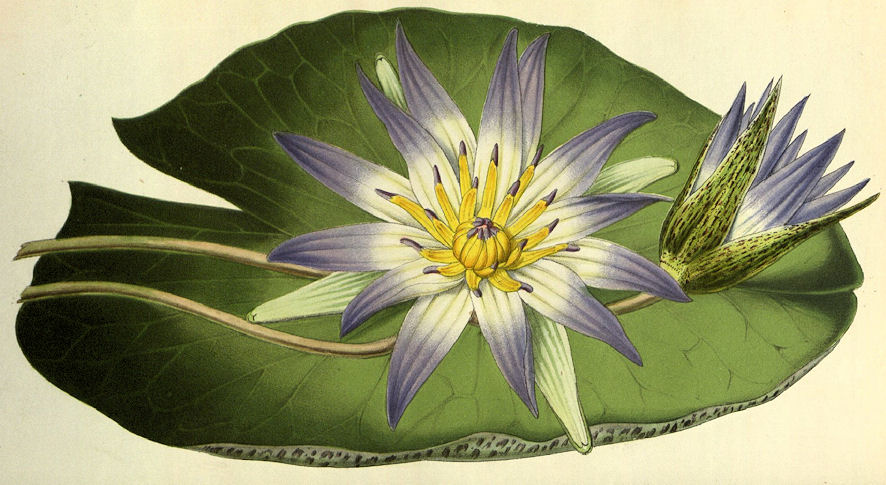
Abb.: नीलाम्बुजन्म
। Nymphaea caerula
Savigny - blue Egyptian lotus - blauer ägyptischer Lotus
[Bildquelle: Flore des serres et des
jardins de l'Europe. -- Vol. 7 (1851). -- Pl. 653]
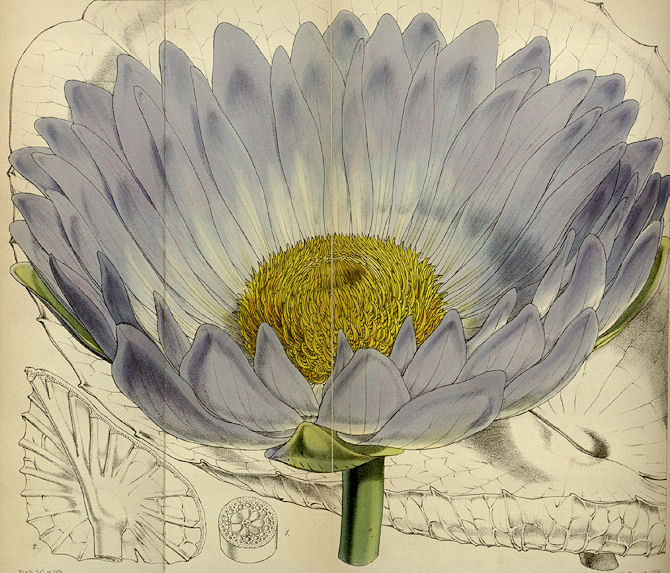
Abb.: इन्दीवरम् । Nymphaea caerula
Savigny - blue Egyptian lotus - blauer ägyptischer Lotus
[Bildquelle: Curtis's Botanical Magazine, v. 78 (1852), Tab.
4647]
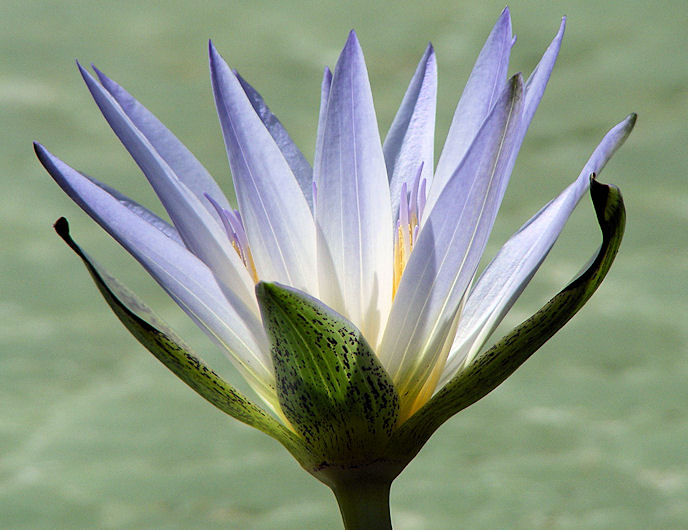
Abb.: इन्दीवरम् । Nymphaea caerula
Savigny - blue Egyptian lotus - blauer ägyptischer Lotus
[Bildquelle: Peripitus / Wikipedia. -- GNU FDLicense]
2 Nymphaea nouchalii Burm. f. - blue lotus - Stern-Seerose
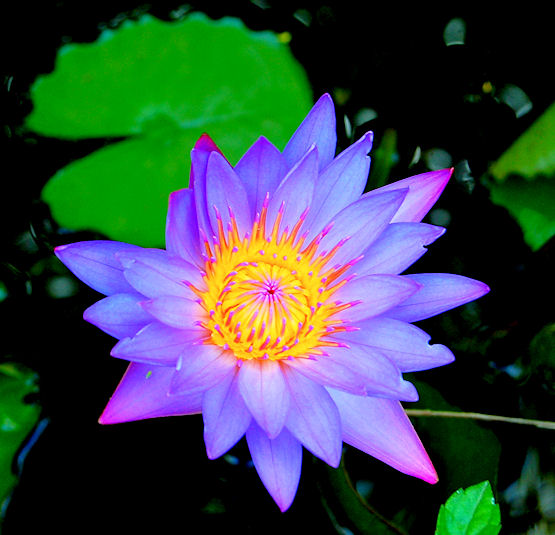
Abb.: इन्दीवरम् । Nymphaea nouchalii Burm. f. -
blue lotus - Stern-Seerose, Myanmar
[Bildquelle: worak. --
http://www.flickr.com/photos/worak/908613624/. -- Zugriff am 2010-09-19.
-- Creative Commons
Lizenz (Namensnennung)]
"Nymphaea cyanea. Roxb. [= Nymphaea nouchalii Burm. f.]
[...]
Sans. Kahlara.
It is a native of similar places with the last two. Root the same as in rubra and Lotus. [...] Flowers pale blue, considerably smaller than either of the former species. [...]
The roots and seeds of this species are also eaten by the natives, but less esteemed than those of the former."
[Quelle: Roxburgh, William <1751-1815>: Flora indica, or, Descriptions of Indian plants / by the late William Roxburgh. -- Serampore : Printed for W. Thacker, 1832. -- Vol. 2, S. 547f.]
37. c./d. indīvaraṃ ca nīle 'smin site kumuda-kairave
इन्दीवरं च नीले ऽस्मिन् सिते कुमुद-कैरवे ॥३७ ख॥
Bezeichnungen für die weiße Seerose (Nymphaea alba L. - white water lily)1 sind:
कुमुद n.: weiße Seerose
कैरव n.: weiße Seerose
1 Nymphaea alba L. - white water lily - weiße Seerose
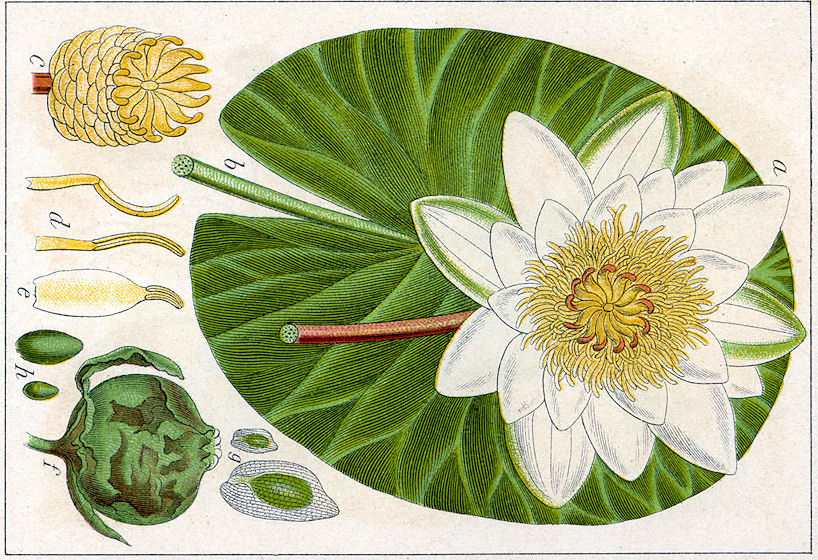
Abb.: कुमुदम् । Nymphaea alba
L. - white water lily - weiße Seerose
[Bildquelle: Sturm, 1796 / Wikimedia. -- Public domain]
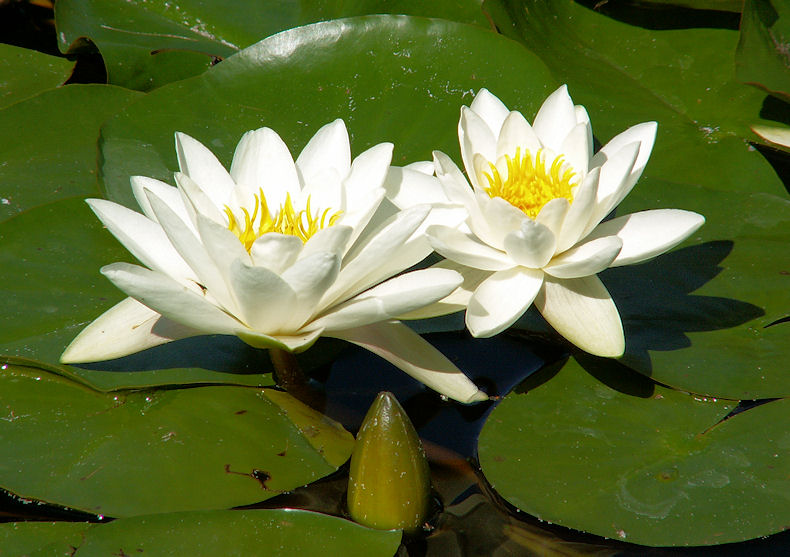
Abb.: कुमुदम् । Nymphaea alba
L. - white water lily - weiße Seerose
[Bildquelle: Opuntia / Wikimedia. -- GNU FDLicense]
38. a./b. śālūkam eṣāṃ kandaḥ syād vāriparṇī tu kumbhikā
शालूकम् एषां कन्दः स्याद् वारिपर्णी तु कुम्भिका ।३८ क।
Die Wurzel (kanda m.) der genannten Pflanzen heißt शालूक n.: Seerosenwurzel, Lotuswurzel
38. a./b. śālūkam eṣāṃ kandaḥ syād vāriparṇī tu kumbhikā
शालूकम् एषां कन्दः स्याद् वारिपर्णी तु कुम्भिका ।३८ क।
[Bezeichnungen für Wassersalat (Pistia stratiotes L. - water lettuce)1 sind:]
वारिपर्णी f.: "Wasserblatt", Wassersalat
कुम्भिका f: "Topf", Wassersalat
Erläuterungen
1 Pistia stratiotes L. - water lettuce - Wassersalat
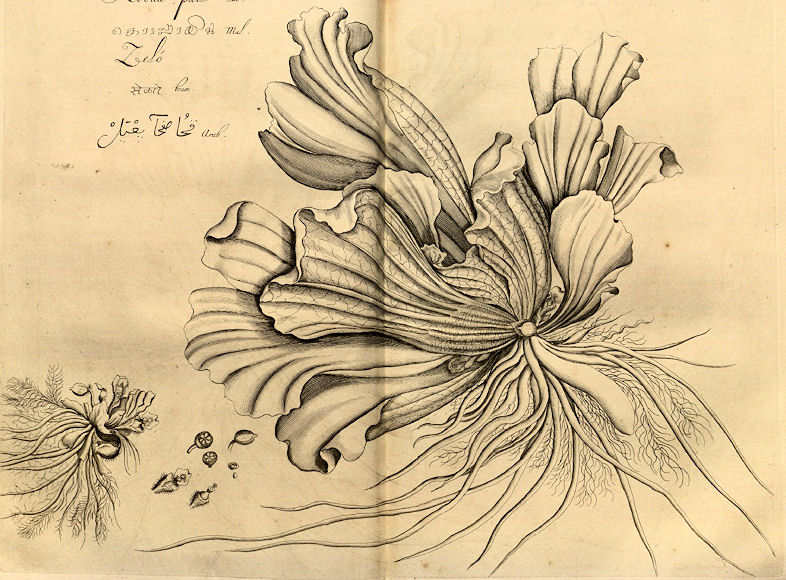
Abb.: कुम्भिका । Pistia stratiotes
L. - water lettuce - Wassersalat
[Bildquelle: Hortus malabaricus XI. Fig. 32,
1692]
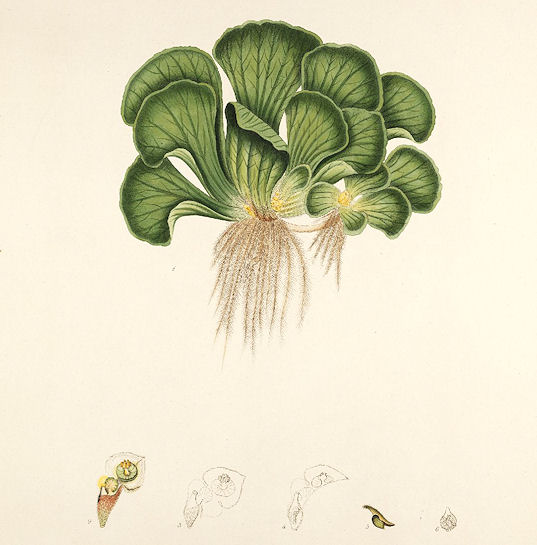
Abb.: वारिपर्णी । Pistia stratiotes
L. - water lettuce - Wassersalat
[Bildquelle: Roxburgh. -- Vol III. -- 1819. --
Tab. 268. -- Image courtesy Missouri Botanical
Garden. http://www.botanicus.org. --
Creative Commons Lizenz
(Namensnennung, keine kommerzielle Nutzung)]
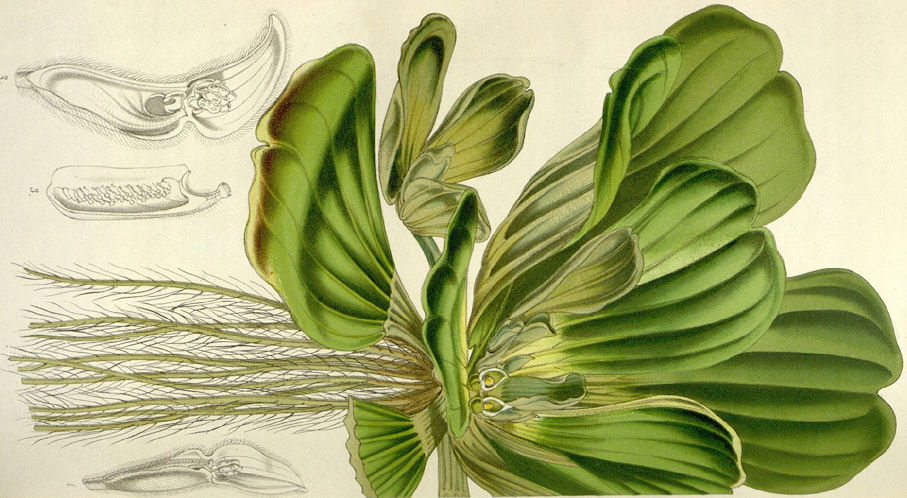
Abb.: कुम्भिका । Pistia stratiotes
L. - water lettuce - Wassersalat
[Bildquelle: Flore des serres et des jardins de l'Europe. -- Vol. 6 (1850). --
Pl. 625]
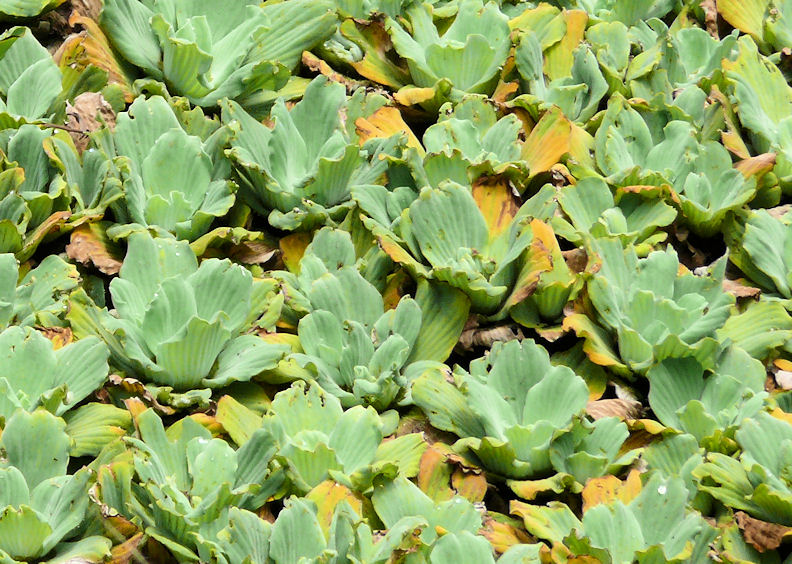
Abb.: वारिपर्णी ।
Pistia stratiotes
L. - water lettuce - Wassersalat
[Bildquelle: Arria Belli / Wikimedia. -- GNU FDLicense]
"Pistia stratiotes. Willd. iii. 690.
Tala indica. Louricr. Cochin Ch. 492.
Sans. Koombhika.
Plantago aquatica. Rumph. Amb. vi. f. 74.
[...]
Found swimming on pools of stagnant water in most parts of India, having much the appearance of half-grown Lettuce plants. Flowering time the hot season, seed ripens after the rains."
[Quelle: Roxburgh, William <1751-1815>: Flora indica, or, Descriptions of Indian plants / by the late William Roxburgh. -- Serampore : Printed for W. Thacker, 1832. -- Vol. 3, S. 131.]
"Pistia stratiotes (Linn.) N. O. Pistiaoeae. [...]
Description.—Stemless, floating;
[...]
Fl. April.
Roxb. Fl. Ind. iii. 131.— Rheede, xi. t. 32.
Tanks and ditches everywhere.
Medical Uses.—This plant is common throughout the country. Adanson affirms in his History of Senegal that the primary root is fixed strongly in the bank. It was suggested by Jacquin that perhaps the young plant may be fixed at first and break loose afterwards. The plant is cooling and demulcent, and is given in dysuria. The leaves are made into poultices and applied to haemorrhoids. In Jamaica, according to Browne, it impregnates the water in hot dry weather with its particles to such a degree as to give rise to the bloody flux. The leaves mixed with rice and cocoa-nut milk are given in dysentery, and with rose-water and sugar in coughs and asthma. The root is laxative and emollient.—Rheede. Ainslie."
[Quelle: Drury, Heber <1819 - 1872>: The useful plants of India : with notices of their chief value in commerce, medicine, and the arts. -- 2d ed. with additions and corrections. London : Allen, 1873. -- xvi, 512 p. ; 22 cm. -- s.v.]
"PISTIA STRATIOTES, Linn.
Fig.—Roxb. Cor. Pl. iii., t. 268 ; Rheede, Hort. Mal. xi., t. 32.
Water soldier
Hab.—Tanks and ponds of India.
[...]
History, Uses, &C.—Amongst the Sanskrit names of this plant we may notice Jalodbhuta, Jalāsaya, Guccha-bodhra, and Paniya-prishthaja ''born on the surface of water." This aquatic plant is a native of Asia, America, and Africa; it is considered by the Hindus to be cooling and demulcent, and is prescribed in cases of dysuria in the quantity of about ten pagodas' weight twice daily; the leaves are made into a poultice for the piles. (Ainslie.) The ashes are applied to ringworm of the scalp, and in some parts of India are known as 'Pānā salt.'
A notice of the plant will be found in Arabic and Persia medical works under its Greek name στρατιωτης.
Description.—Often found floating on stagnant pools"
[Quelle: Pharmacographia indica : a history of the principal drugs of vegetable origin met with in British India / by William Dymock [1834-1892], C. J. H. Warden and David Hooper [1858-1947]. -- Bd. 3. -- London, 1893. -- S. 550.]
38. c./d. jalanīlī tu śaivālaṃ śaivalo 'tha kumudvatī
जलनीली तु शैवलं शैवलो ऽथ कुमुद्वती ॥३८ ख॥
[Bezeichnungen für Hornblatt (Ceratophyllum sp. - hornwort)1 sind:]
जलनीली f.: "Wasserschwarze", Hornblatt
शैवल n.: Hornblatt2
शैवल m.: Hornblatt2
1 Hornblatt (Ceratophyllum sp. - hornwort)
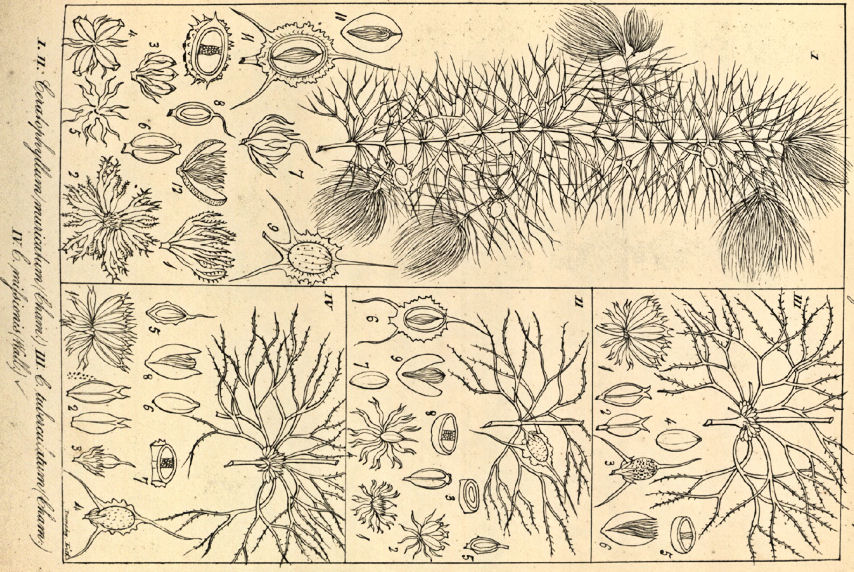
Abb.: जलनीली।
I. II. Ceratophyllum muricatum Cham. III. C. tuberculatum Cham.
IV. C. missionis Wall.
[Bildquelle: Wight Icones VI, Tab. 195, 1948]
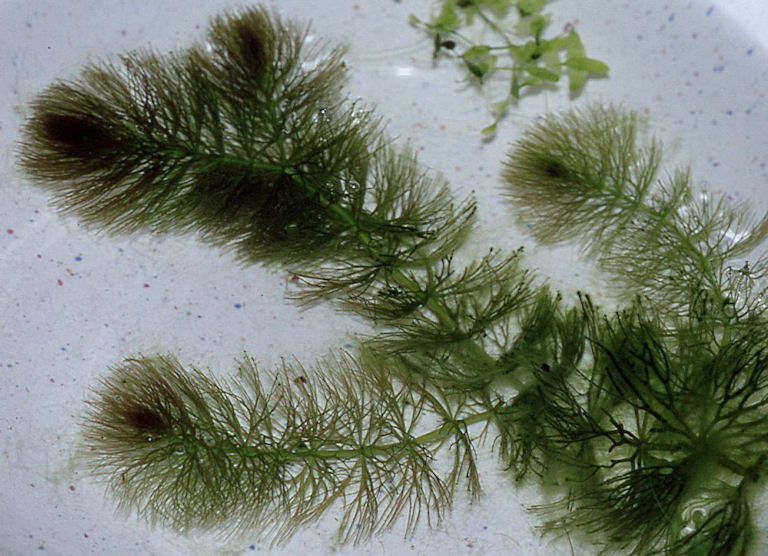
Abb.: Verwandter von शैवलः । Ceratophyllum submersum L. - soft hornwort - zartes
Hornblatt
[Bildquelle: Christian Fischer / Wikipedia. -- GNU FDLicense]
"Ceratophyllum verticillatum. Roxb.
[...]
Found in pools of sweet water in the vicinity of Calcutta during the dry season."
[Quelle: Roxburgh, William <1751-1815>: Flora indica, or, Descriptions of Indian plants / by the late William Roxburgh. -- Serampore : Printed for W. Thacker, 1832. -- Vol. 3, S. 624.]
2 PW: Blyxa octandra Planch. ex Thw. 1864
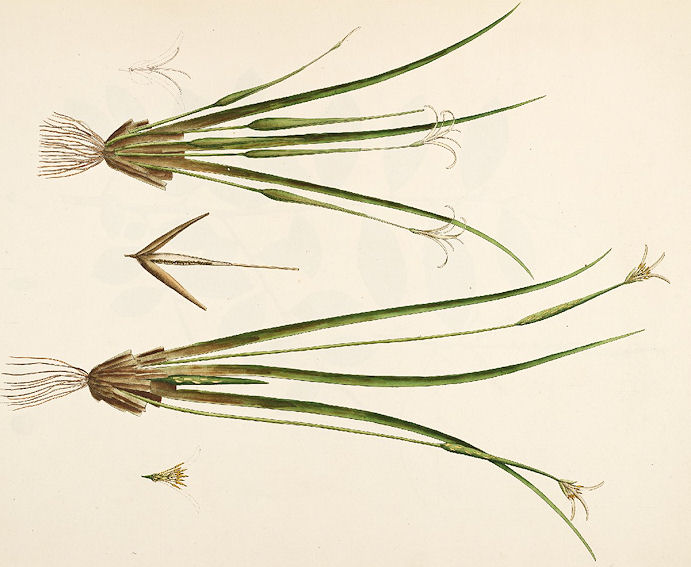
Abb.: शैवलः । Blyxa
octandra Planch. ex Thw. 1864 (Roxb.:
Vallisneria octandra)
[Bildquelle: Roxburgh. -- Vol II. -- 1795. --
Tab. 165. -- Image courtesy Missouri Botanical Garden.
http://www.botanicus.org. --
Creative Commons Lizenz
(Namensnennung, keine kommerzielle Nutzung)]
"Vallisneria octandra. Willd. iv. 651. Corom. pl. ii. 165. 475. [= Blyxa octandra Planch. ex Thw. 1864]
[...]
Saivala. Asiat. Res. iv. 275.
A grass-like plant, growing in standing, shallow, sweet water.
Root fibrous, annual.
[...]
They are all found in lakes and in stagnant pools of sweet water, and as in V. spiralis, the male flowers, when ready to expand, detach themselves from the plant, and are borne, as the wind directs over the surface of the water, resting on the tips of their reflected petals in search of the female flowers."
[Quelle: Roxburgh, William <1751-1815>: Flora indica, or, Descriptions of Indian plants / by the late William Roxburgh. -- Serampore : Printed for W. Thacker, 1832. -- Vol. 3, S. 752f.]
38. c./d. jalanīlī tu śaivālaṃ śaivalo
'tha kumudvatī
39. a./b. kumudinyāṃ nalinyāṃ tu
visinī-padminī-mukhāḥ
जलनीली तु शैवलं शैवलो
ऽथ कुमुद्वती ॥३८ ख॥
कुमुदिन्यां नलिन्यां तु विसिनी-पद्मिनी-मुखाः
।३९ क।
Ein Gewässer voller weißer Seerosen (kumudinī f. "durch weiße Seerosen Gekennzeichnete") nennt man कुमुद्वती f.: "mit weißen Seerosen Gefüllte".
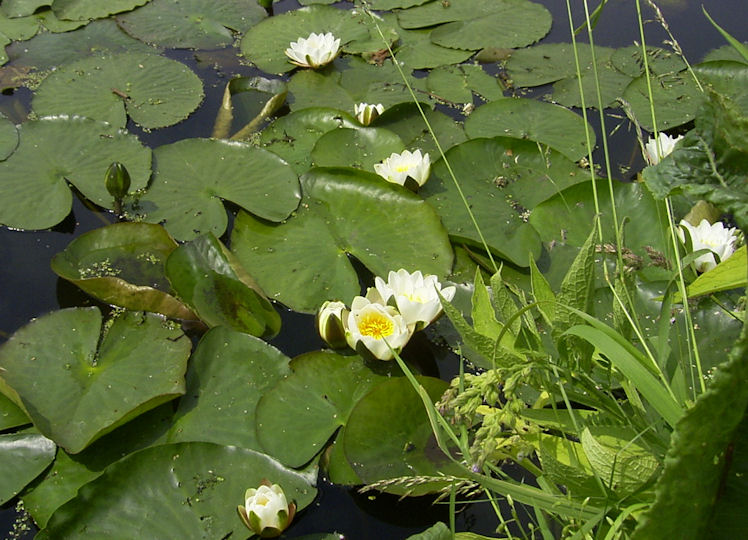
Abb.: कुमुदिनी ।
[Bildquelle: TeunSpaans / Wikimedia. -- GNU FDLIcense]
39. a./b. kumudinyāṃ nalinyāṃ tu visinī-padminī-mukhāḥ
कुमुदिन्यां नलिन्यां तु विसिनी-पद्मिनी-मुखाः ।३९ क।
Ein Gewässer voll indischem Lotus (नलिनी f. - Lotusteich) nennt man:
विसिनी f.: Lotusteich
पद्मिनी f.: Lotusteich
u. ä.
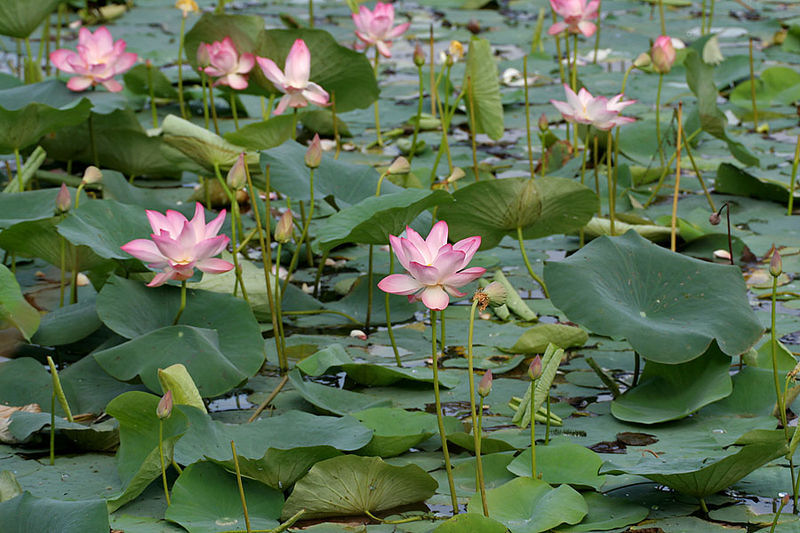
Abb.: पद्मिनी । Hyderabad
హైదరాబాద్ -
حیدرآباد
[Bildquelle: J. M. Garg / Wikimedia. -- GNU FDlicense]
39. c./d. vā puṃsi padmaṃ nalinam
aravindaṃ mahotpalam
40. sahasrapatraṃ kamalaṃ śatapatraṃ kuśeśayam
paṅkeruhaṃ tāmarasaṃ sārasaṃ
sarasīruham
41. a./b. bisaprasūna-rājīva-puṣkarāmbhoruhāṇi ca
वा पुंसि पद्मं नलिनम् अरविन्दं महोत्पलम् ॥३९ ख॥
सहस्रपत्रं कमलं शतपत्रं कुशेशयम् ।
पङ्केरुहं तामरसं सारसं सरसीरुहम् ॥४०॥
बिसप्रसून-राजीव-पुष्कराम्भोरुहाणि च ।४१ क।
[Bezeichnungen für die indische Lotusblume (Nelumbo nucifera Gaertn. - sacred Indian Lotus)1 sind:]
पद्म n., m.: Lotus, die Zahl 1015 bzw. 109
नलिन n.: Lotus
अरविन्द n.: Lotus
महोत्पल n.: großer Lotus
सहस्रपत्र n.: Tausendblatt2
कमल n.: Lotus
शतपत्र n.: Hundertblatt2
कुशेशय n.: auf Kuśa-Gras Liegendes3
पङ्केरुह n.: im Schlamm Wachsendes4
तामरस n.: Gemütsstimmung Sehnsucht, Lotus, Lotusteich
सारस n.: Teichpflanze (= Lotus)
सरसीरुह n.: im Teich Wachsendes
बिसप्रसून n.: Blüte aus dem Stängel5
राजीव n.: Gestreiftes, Lotus6
पुष्कर n.: Lotus
अम्भोरुह n.: im Wasser Wachsendes
Erläuterungen:
1 Nelumbo nucifera Gaertn. - sacred Indian Lotus - indische Lotusblume
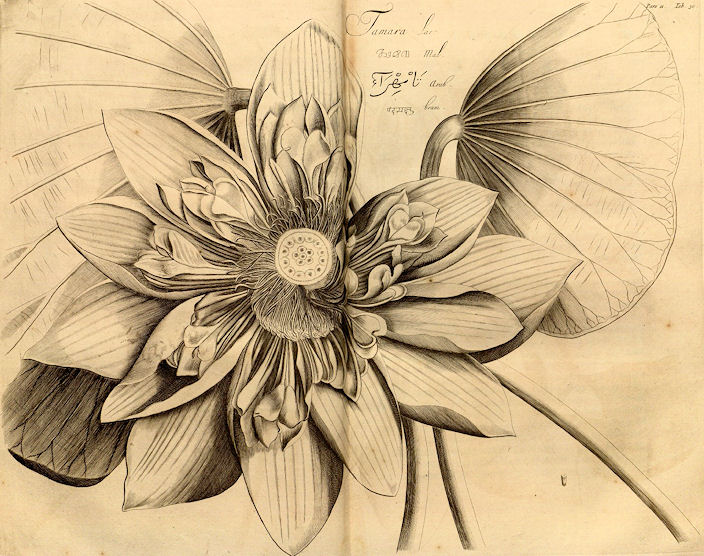
Abb.: पद्मम् ।
Nelumbo nucifera Gaertn. - sacred Indian Lotus - indische Lotusblume
[Bildquelle: Hortus malabaricus XI. Fig. 30,
1692]
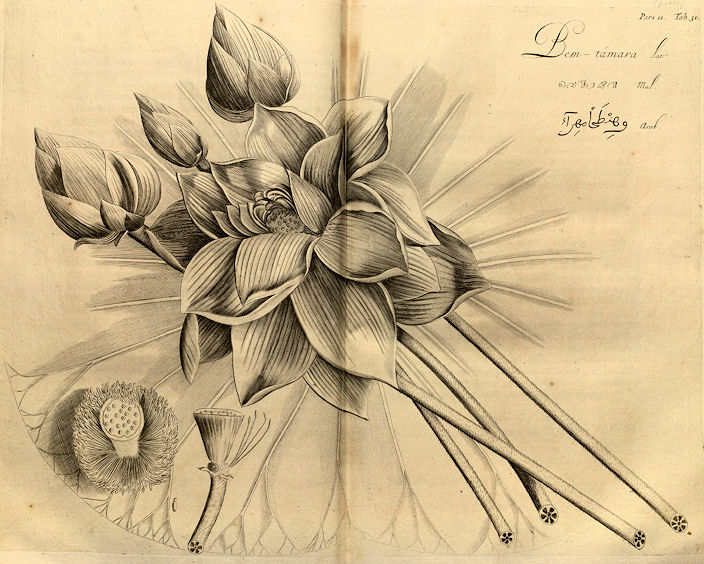
Abb.: पद्मम् ।
Nelumbo nucifera Gaertn. - sacred Indian Lotus - indische Lotusblume
[Bildquelle: Hortus malabaricus XI. Fig. 31,
1692]
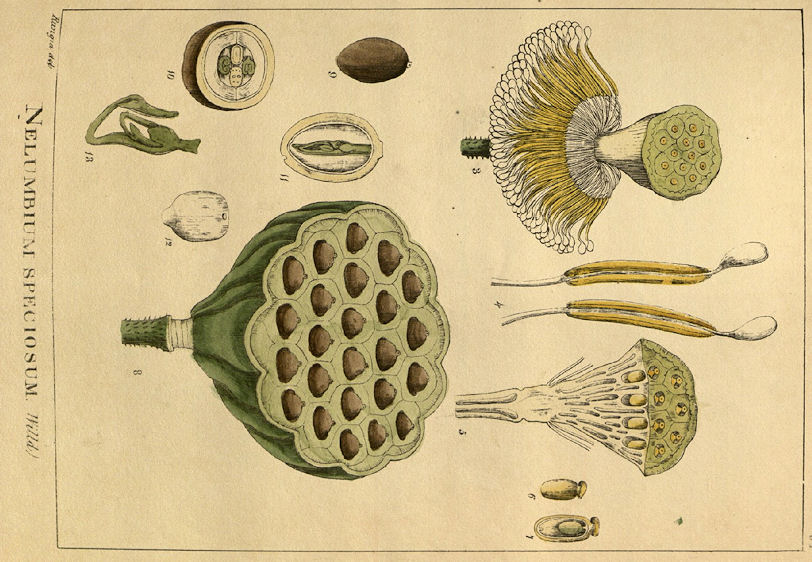
Abb.: पद्मम् ।
Nelumbo nucifera Gaertn. - sacred Indian Lotus - indische Lotusblume
[Bildquelle: Wight: Illustrations I, Tab. 9a,
1840]
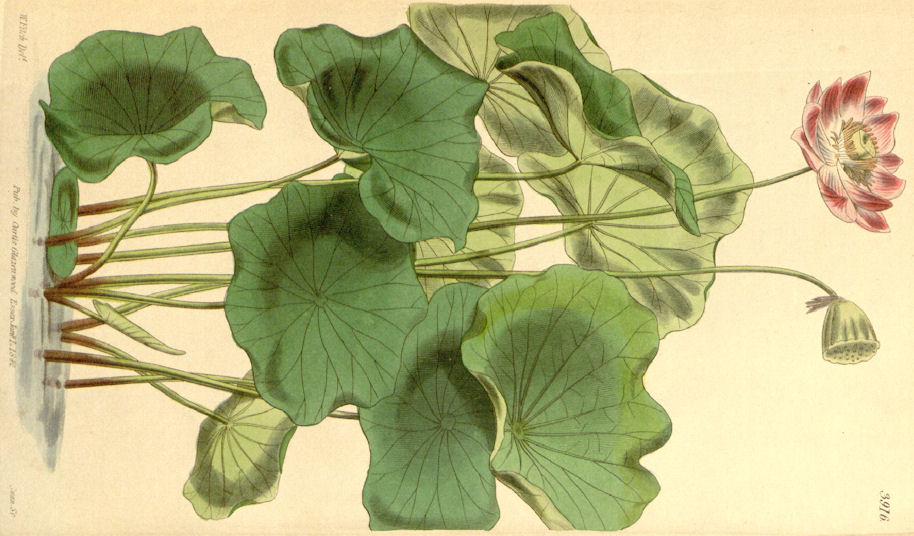
Abb.: पद्मम् ।
Nelumbo nucifera Gaertn. - sacred Indian Lotus - indische Lotusblume
[Bildquelle: Curtis's Botanical Magazine, v. 68 (1841), Tab. 3916]
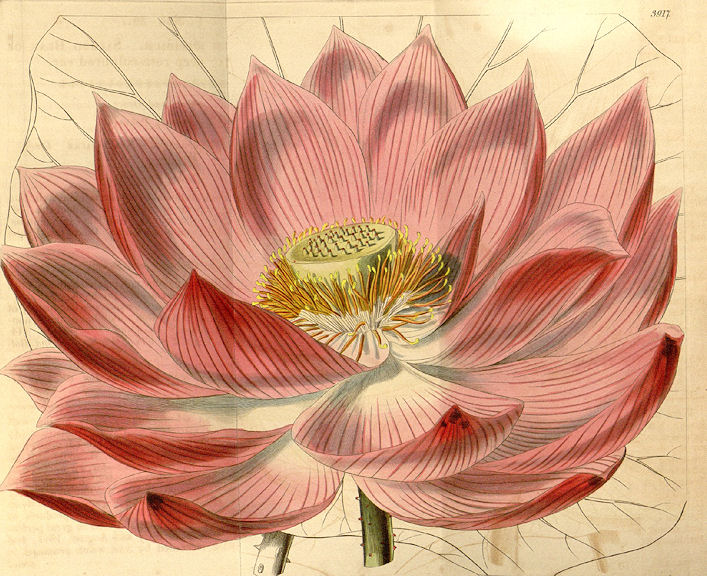 S
S
Abb.: पद्मम् ।
Nelumbo nucifera Gaertn. - sacred Indian Lotus - indische Lotusblume
[Bildquelle: Curtis's Botanical Magazine, v. 68 (1841), Tab. 3917]
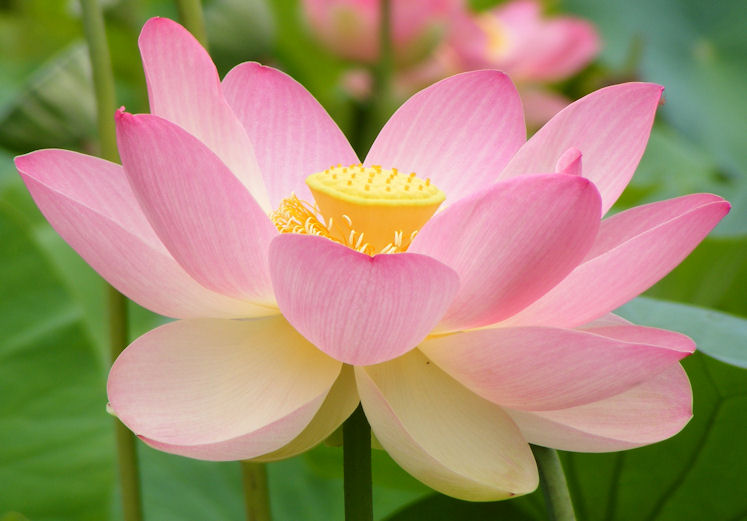
Abb.: पद्मम् ।
Nelumbo nucifera Gaertn. - sacred Indian Lotus - indische Lotusblume
[Bildquelle: Peripitus / Wikipedia. -- GNU FDLicense]
Siehe:
Carakasaṃhitā: Ausgewählte Texte aus der Carakasaṃhitā / übersetzt und erläutert von Alois Payer <1944 - >. -- Anhang A: Pflanzenbeschreibungen. -- Nelumbo nucifera Gaertn. -- URL: http://www.payer.de/ayurveda/pflanzen/nelumbo_nucifera.htm
"Nelumbium speciosum. Willd. 2. 1258.
[...]
Tamara. Rheed. Mal. xi. t. 30.
Padma. Asiat. Res. 4. 286.
Sungs. Pudma, Muhotpula.
The red variety, Ruktotpula, Kokunuda.
Sungs. The white sort, Poondureeka, Sitambuja.
[...]
I have met with only two sorts on the coast of Coromandel, one with rose-coloured flowers, the other with flowers perfectly white, and since that time a third variety has been brought from China with smaller rosy flowers. They grow in such sweet-water lakes, &c. as do not dry up during the driest season, and on the coast, flower all the year round. In Bengal they flower during the hot season, April, May and June, and ripen their seed about the close of the rains. Root creeping in mud, jointed at various distances, in general, fully as thick as the fore-finger, of uncertain length, but it must be very great; smooth, generally tinged with red, perforated internally with many pores. The joints in old plants are often swelled into tubulosities of various sizes ; sometimes as large as a man's fist ; from them issue many fungous fibres, and from the upper and the interior part of these tubulosities issue one, two, or more leaves and flowers ; their insertions being surrounded with spathe-like sheaths. Leaves radical, from the joints, petioled, peltate, floating on the water
[...]
The white Nelumbium differs in few respects from the red one, and may be considered as only a variety of it. [...]
The tender shoots of the roots between the joints of both sorts are eaten by the natives, either simply boiled or in their curries. The seeds are eaten raw, roasted or boiled. The leaves are used to eat off instead of plates.
These holy and beautiful plants are often met with in the religious ceremonies of the Hindoos under their Sanscrit name Padma."
[Quelle: Roxburgh, William <1751-1815>: Flora indica, or, Descriptions of Indian plants / by the late William Roxburgh. -- Serampore : Printed for W. Thacker, 1832. -- Vol. 2, S. 647ff.]
"Nelumbium speciosum (Willd.) N. O. Nelumbiaceae. Egyptian or Pythagorean Bean
[...]
Description.—Aquatic; [...] flowers large, white or rose-coloured.
Fl. nearly all the year.
W. & A. Prod. i. 16. — Wight Ill. i. t 9.—Roxb. Fl. Ind. ii. 647.
Nymphaea Nelumbo, Linn.—Rheede, xi. t. 30, 31.
Common in tanks in the Peninsula and other parts of India.
Economic Uses.—It is universally believed that this is the sacred Egyptian Lotus, which originally found its way from India, where it was indigenous, and the fruit was known as the Pythagorean bean. If this be the case, it is a singular fact that, while the plant still survives in its native country, it has died out after the lapse of centuries in Egypt, for the real Lotus is no longer found on the waters of the Nile. Up to the 17th century it was commonly believed to be peculiar to Lower Egypt, but no one had ever met with it there. Herodotus has alluded to the plant, and indeed accurately describes it. He called it the "Lily of the Nile," but this must not be confounded with several species of the Nymphaea tribe which are found in the Nile to the present day. Of the Lotus he says,—"There are also other lilies, like roses, that grow in the river, the fruit of which is contained in a separate pod, that springs up from the root in form very like a wasp's nest; in this there are many berries fit to be eaten, of the size of an olive stone, and they are eaten both fresh and dried." It grew abundantly in all the lakes and canals. Strabo and particularly Theophrastus have both mentioned the sacred plant of Egypt, and the latter has most minutely described it, but the savans who accompanied Napoleon in his expedition to that country looked in vain for it It has long ago disappeared. The most remarkable part of the plant is the structure of the seed-receptacle, which has been aptly compared to a pomegranate cut in half, or, as Herodotus says, like a wasp's nest. When ripe, the seeds are loose each in their separate cell, and if shaken make a noise like a rattle. Unlike the Nymphaea, the stems, petioles, and flower-stems of the Lotus are raised above the water, a peculiarity which may serve to distinguish it, where so many errors have been made in the specification of the two genera. In this country as well as in China and Ceylon the flowers are held especially sacred. The roots and seeds were eaten by the Egyptians in the time of Herodotus, as they are now in India. It is also cultivated for the purpose. The mode of sowing the seeds is by first enclosing them in balls of clay and then throwing them into the water. The same method was adopted by the early Egyptians. Sir J. Staunton remarked that the leaf from its structure growing entirely round the stalk has the advantage of defending both flowers and fruit arising from its centre from contact with the water. The stem never fails to ascend with the water from whatever depth, where its leaf expands, rests upon it, and often rises above it. There are several varieties with white or rose-coloured flowers, and with or without a prickly stem. When the tanks are dry the roots are embedded in the mud, but on the appearance of the rain they burst out again, and the surface of the water, as if by a miracle, becomes covered with the large broad leaves. As a modern writer has observed, "There is no plant in the world which possesses so much interest in an historical point of view as the Lotus. The emblem of sanctity amongst the priests of an extinct religion four thousand years ago, it is now no longer known in the countries where once it was held sacred, and has sought refuge in the gardens and conservatories of the far-off lands of the west, of which the votaries of Isis never dreamt." Dr Roxburgh says that the tender shoots of the roots between the joints are eaten by the natives either simply boiled or in their curries. The seeds are eaten either raw, roasted, or boiled. The leaves and flower-stalks abound in spiral tubes, which are extracted with great care by gently breaking the stems and drawing apart the ends; with these filaments are prepared those wicks which are burnt by the Hindoos in the lamps placed before the shrines of their gods. The leaves are used as substitutes for plates; and in China the seeds and slices of the root are served up in summer with ice, and the roots are laid up in salt and vinegar for the winter.—Roxb. Loudon".
[Quelle: Drury, Heber <1819 - 1872>: The useful plants of India : with notices of their chief value in commerce, medicine, and the arts. -- 2d ed. with additions and corrections. London : Allen, 1873. -- xvi, 512 p. ; 22 cm. -- s.v.]
"NELUMBIUM SPECIOSUM, Wight. Fig. — Wight, III. i., t. 9; Bot. Mag., t. 903; Rheede, Hort. Mal. xi., 30, 31.
Egyptian Lotus
Hab .—India, Persia, Ceylon, Siam, Cochin-China, Philippines, Moluccas, China and Japan.
[...]
History, Uses, &c.
This is a classical plant amongst .the Hindus and Egyptians. The world at its creation is likened to a Lotus flower floating on water. Om I mani padme. Om ! the pearl of creation is in the Lotus. - It is emblematic of the heavens, Brahma is supposed to reside on a Lotus flower in a sea of milk, and to sleep six months of the year, and watch the other six months; an allusion to the seasons in which Brahma represents the Sun. Mr. O. C. Dutt, in his Hindu Materia Medica, speaks thus of it:—"These beautiful plants have attracted the attention of the ancient Hindus from a very remote period, and have obtained a place in their religious ceremonies and mythological fables; hence they are described in great detail by Sanskrit writers. The flowers of N. speciosum, called Padma or Kamala, are sacred to Lakshmi, the goddess of wealth and prosperity. The white variety of this plant is called Pundarika, the red Kokanada, and the blue Indivara. The entire plant, including root, stem and flowers, is called Padmini. The torus or receptacle for the seed is called Karmikara, and the honey formed in the flowers Makaranda. The filaments round the base of the. receptacle pass by the name of Kinjalka, and the leaf stalk by that of Mrinala." N. speciosum is the
κυαμος αιγυπτιος of Theophrastus. Tho Arabians and Persians, under the name of Nilufer, which, they say, is a corruption of an Indian name, and derived from Nila, water, and Phala, fruit, describe the several varieties of Nelumbium and Nymphaea, and do not appear to consider the flowers of the former plant in any way superior to the latter. They direct the white and blue kinds to be preferred. Both Hindus and Mahometans consider the flowers to be especially cooling and astringent, and consequently prescribe them in a variety of disorders which are supposed to proceed from heated humours, such as sanguiueous fluxes from the bowels, &c.; they are given in decoction with liquorice or in the form of a syrup containing 1/2 a part of the dried flowers, 1 part sugar, and 5 parts water, dose 2 to 3 drachms. A powder is also used. As an externally cooling application Lotus flowers, are made into a paste with sandalwood or emblic myrobalans.The seeds of N speciosum (Kamal kakrī), and of Euryale ferox (Makhāna) are used as articles of diet. In times of scarcity the roots and scapes (bishi) of N. speciosum are also made use of, but they are bitter and unpalatable. The starch contained in the thick rhizome, separated by rasping and washing, constitutes a sort of arrowroot used by the Chinese, under the name of Gaan-feen. (D. Hanbury.)
[...]
Commerce.—The seeds are imported from Persia in large quantities as an article of diet. The fresh flowers are brought to market in August for use in the temples. The dried flowers sold in shops as Kamal are generally those of Nymphaea."
[Quelle: Pharmacographia indica : a history of the principal drugs of vegetable origin met with in British India / by William Dymock [1834-1892], C. J. H. Warden and David Hooper [1858-1947]. -- Bd. 1. -- London, 1890. -- S. 70ff.]
2 सहस्रपत्र n.: Tausendblatt ; शतपत्र n.: Hundertblatt
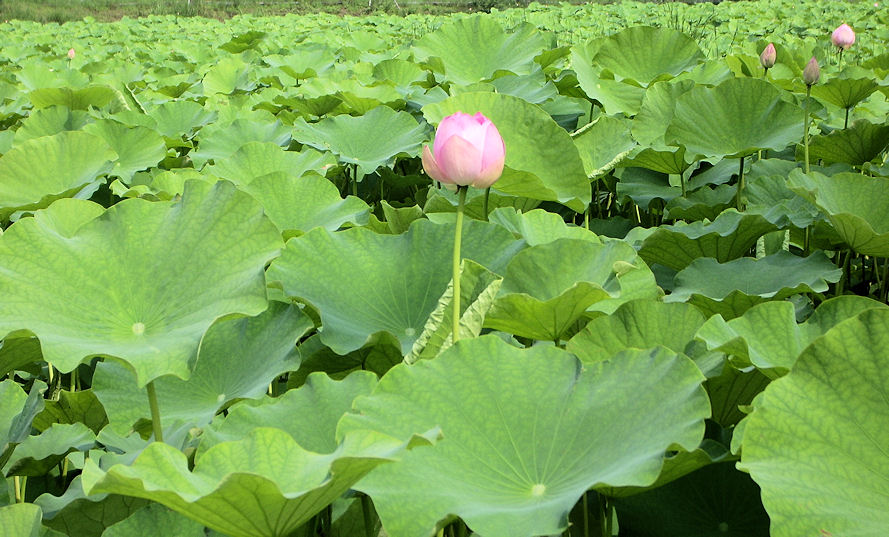
Abb.: सहस्रपत्रम् ।
शतपत्रम् ।
[Bildquelle: Feth / Wikimedia. -- GNU FDLicense]
3 कुशेशय n.: auf Kuśa-Gras Liegendes
Kuśa-Gras = Desmostachys bipinnata (L.) Stapf
Kuśa ist "das heilige, bei verschiedenen religiösen Zeremonien verwendete Gras ..., ein Gras mit hohen Halmen, welche von zahlreichen, langen Blättern umgeben sind." (PW)
4 पङ्केरुह n.: im Schlamm Wachsendes
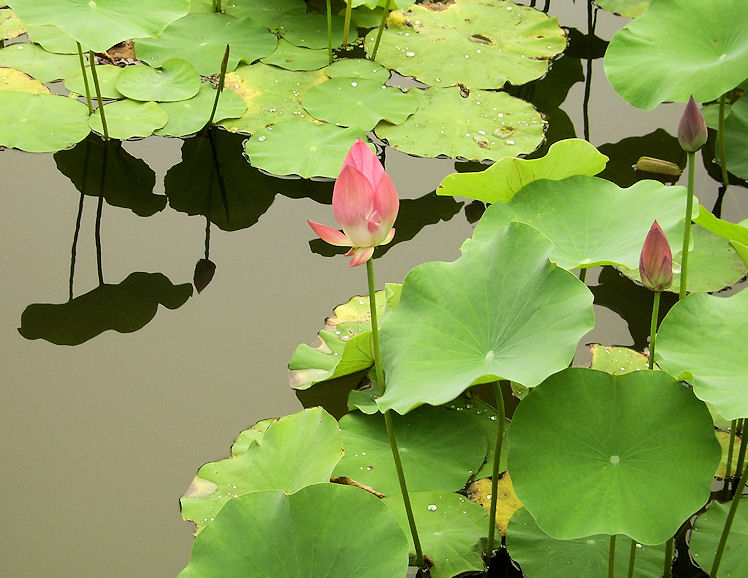
Abb.: पङ्केरुहम् ।
[Bildquelle: Shizhao / Wikimedia. -- GNU FDLicense]
5 बिसप्रसून n.: Blüte aus dem Stängel
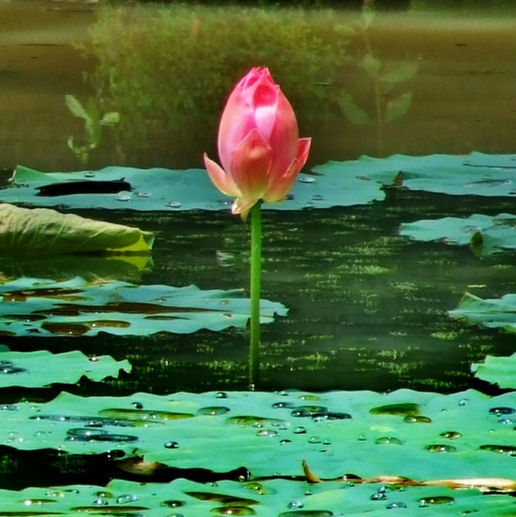
Abb.: बिसप्रसूनम् ।
[Bildquelle:
Neil Howard. --
http://www.flickr.com/photos/neilsingapore/469309736/. -- Zugriff am
2010-09-20. -- Creative
Commons Lizenz (Namensnennung, keine kommerzielle Nutzung)]
6 राजीव n.: Gestreiftes, Lotus
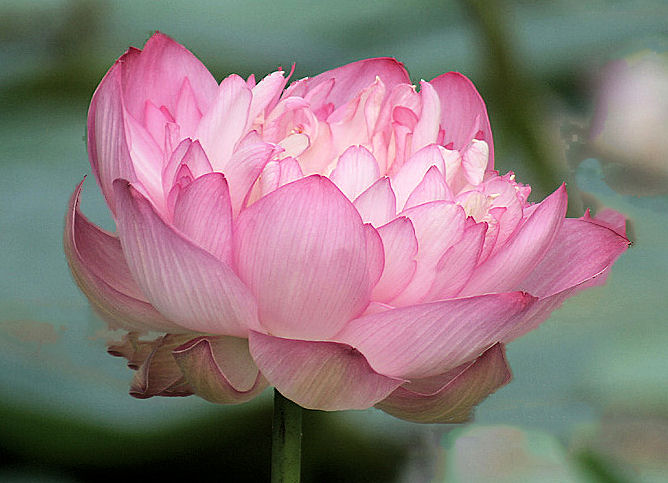
Abb.: राजीवम् ।
[Bildquelle: J. M. Garg / Wikimedia. -- GNU FDLicense]
41. c./d. puṇḍarīkaṃ sitāmbhojam atha raktasaroruhe
पुण्डरीकं सिताम्भोजम् अथ रक्तसरोरुहे ॥४१ ख॥
Ein weißer indischer Lotus (Nelumbo nucifera Gaertn.) heißt पुण्डरीक n.: weißer Lotus
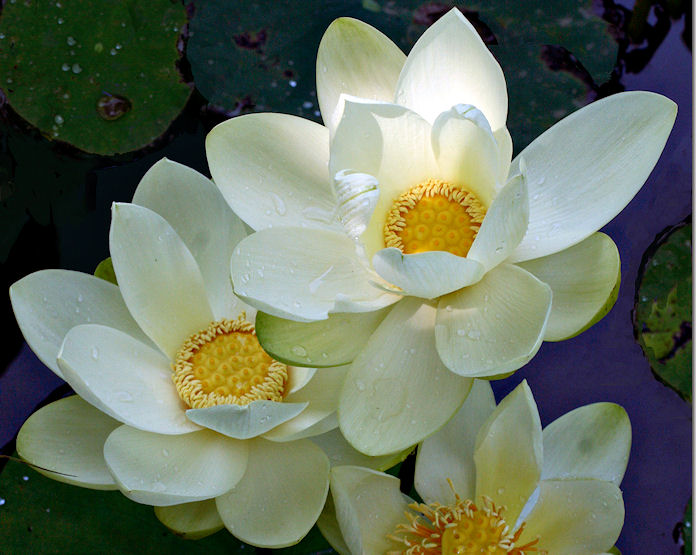
Abb.: पुण्डरीकम् ।
[Bildquelle:
Cindy See. --
http://commons.wikimedia.org/wiki/File:Lotus_8480.jpg. -- Zugriff am
2010-09-20. --
Creative Commons Lizenz (Namensnennung, share alike)]
41. c./d. puṇḍarīkaṃ sitāmbhojam
atha raktasaroruhe
42. a./b. raktotpalaṃ kokanadaṃ nālo nālam athāstriyām
पुण्डरीकं सिताम्भोजम्
अथ रक्तसरोरुहे ॥४१ ख॥
रक्तोत्पलं कोकनदं नालो नालम् अथास्त्रियाम् ।४२ क।
Bezeichnungen für den roten indischen Lotus (रक्तसरोरुह n.) (Nelumbo
nucifera Gaertn.) sind:
रक्तोत्पल n.: roter Lotus
कोकनद n.: roter Lotus
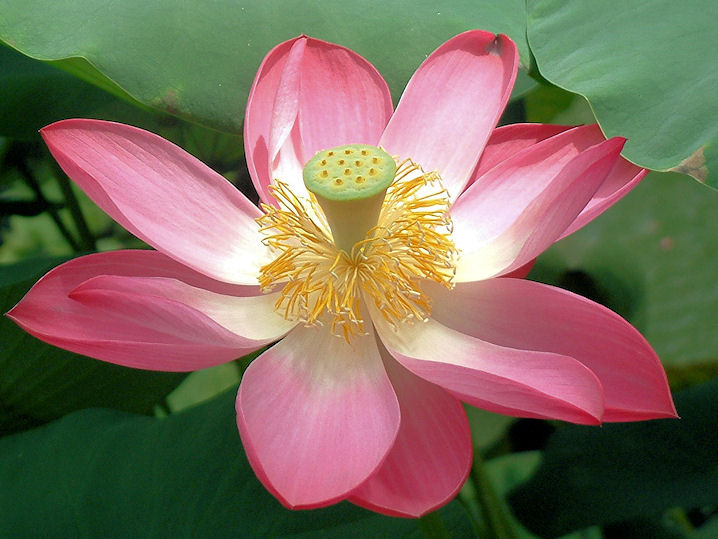
Abb.: कोकनदम् ।
[Bildquelle: Radomil / Wikimedia. -- GNU FDLicense]
42. a./b. raktotpalaṃ kokanadaṃ nālo nālam athāstriyām
रक्तोत्पलं कोकनदं नालो नालम् अथास्त्रियाम् ।४२ क।
[Bezeichnungen für den Lotusstängel (Nelumbo nucifera Gaertn.) sind:]
नाल m.: Stängel, Stiel, Röhre, Lotusstängel
नाल n.: Stängel, Stiel, Röhre, Lotusstängel
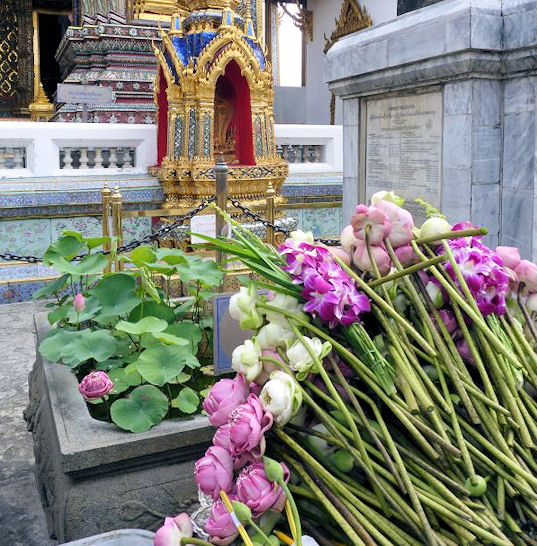
Abb.: नालाः । Wat Phra Kaew -
วัดพระแก้ว,
Bangkok - กรุงเทพฯ, Thailand
[Bildquelle: vamp_v2. --
http://www.flickr.com/photos/vamp_v2/4444666869/. -- Zugriff am 2010-09-20.
-- Creative
Commons Lizenz (Namensnennung, keine kommerzielle Nutzung, share alike)]
42. raktotpalaṃ kokanadaṃ nālo nālam
athāstriyām
mṛṇālaṃ bisam abjādikadambe
khaṇḍam astriyām
रक्तोत्पलं कोकनदं नालो नालम् अथास्त्रियाम् ।
मृणालं बिसम् अब्जादिकदम्बे खण्डम्
अस्त्रियाम् ॥४२॥
[Bezeichnungen für Lotuswurzelfaser1 (Nelumbo nucifera Gaertn.) sind:]
मृणाल n., m.: Lotuswurzel, Lotusfaser
बिस n., m.: Lotusstängel, Wurzelschoß, Lotusfaser
Erläuterungen:
1 Lotuswurzelfaser
Aus der Lotuswurzel gewonnen.

Abb.: मृणालानि ।
[Bildquelle:
Windell Oskay. --
http://www.flickr.com/photos/oskay/2436301930/. -- Zugriff am 2010-09-20. --
Creative Commons
Lizenz (Namensnennung)]
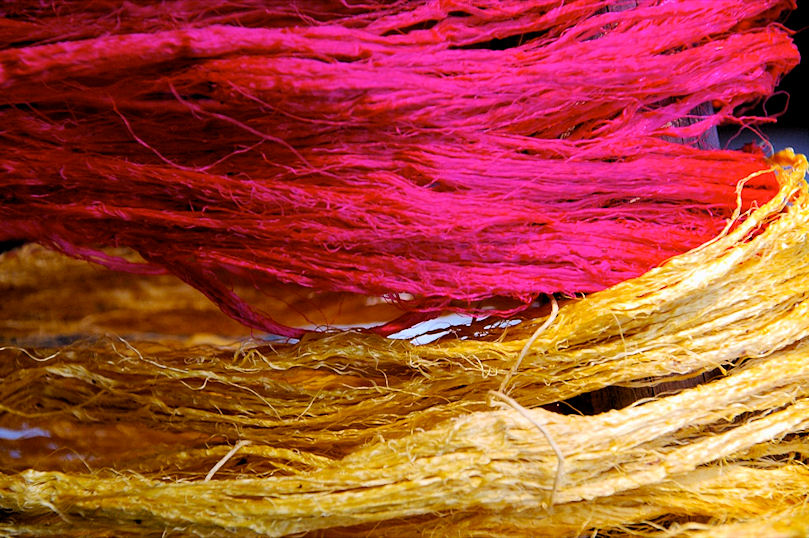
Abb.: मृणालानि । Gefärbte Lotuswurzelfasern, Nyaung Shwe
ညောင်ရွှေမြို့,
Myanmar
[Bildquelle:
Andrew. --
http://www.flickr.com/photos/leprecon/407570873/. -- Zugriff am 2010-09-20.
-- Creative
Commons Lizenz (Namensnennung, keine kommerzielle Nutzung, keine
Bearbeitung)]
"Lotus root is used to make a coarse, flax like fiber. The method of extracting the fiber is incredibly labour intensive and the fabric, although coarse compared to silk, is very highly valued.Garments made of this fiber were far more expensive than the most delicate silks. A simple shirt would have cost over $us50 where the most expensive silk garments were well under $30.
Many are used for religious ceremonial garments." (Andrew, a.a.O.)
42. c./d. mṛṇālaṃ bisam abjādikadambe khaṇḍam astriyā
मृणालं बिसम् अब्जादिकदम्बे खण्डम् अस्त्रियाम् ॥४२॥
Eine Menge (कदम्ब n.: Menge, Schar) von Lotus und dergleichen heißt खण्ड m.,
n.: Anzahl, Menge
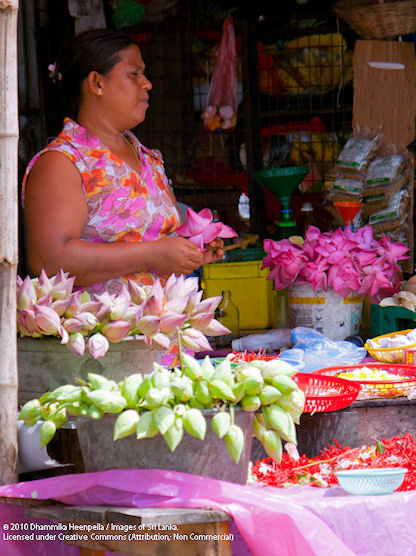
Abb.: अब्जखण्डः । Sri Lanka
[Bildquelle:
Dhammika Heenpella. --
http://www.flickr.com/photos/photosofsrilanka/4658896361/. -- Zugriff am
2010-09-20. -- Creative
Commons Lizenz (Namensnennung, keine kommerzielle Nutzung)]
43. a./b. karahāṭaḥ śiphākandaḥ kiñjalkaḥ kesaro 'striyām
करहाटः शिफाकन्दः किञ्जल्कः केसरो ऽस्त्रियाम् ।४३ क।
[Bezeichnungen für Lotuswurzel (Nelumbo nucifera Gaertn.) sind:]
करहाट m.: Lotuswurzel
शिफाकन्द m.: fasrige Wurzel, Lotuswurzel

Abb.: शिफाकन्दाः ।
[Bildquelle:
Robin. --
http://www.flickr.com/photos/fotoosvanrobin/2791370777/. -- Zugriff am
2010-09-20. --
Creative
Commons Lizenz (Namensnennung, keine kommerzielle Nutzung, keine
Bearbeitung)]
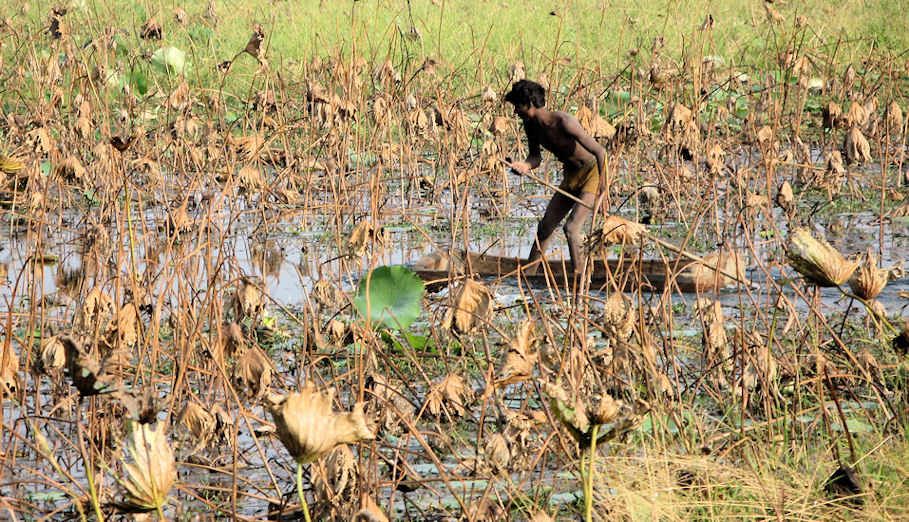
Abb.: Lotuswurzel-Sammler, Bundi district - बूँदी जिला, Rajasthan
[Bildquelle: MACSURAK. --
http://www.flickr.com/photos/macsurak/2133356479/. -- Zugriff am 2010-09-20.
-- Creative Commons
Lizenz (Namensnennung)]
43. a./b. karahāṭaḥ śiphākandaḥ kiñjalkaḥ kesaro 'striyām
करहाटः शिफाकन्दः किञ्जल्कः केसरो ऽस्त्रियाम् ।४३ क।
[Bezeichnungen für Staubfäden (des Lotus - Nelumbo nucifera Gaertn.) sind:]
किञ्जल्क m.: Staubfaden
केसर m., n.: Augenbrauenhaar, Mähne, Staubfaden
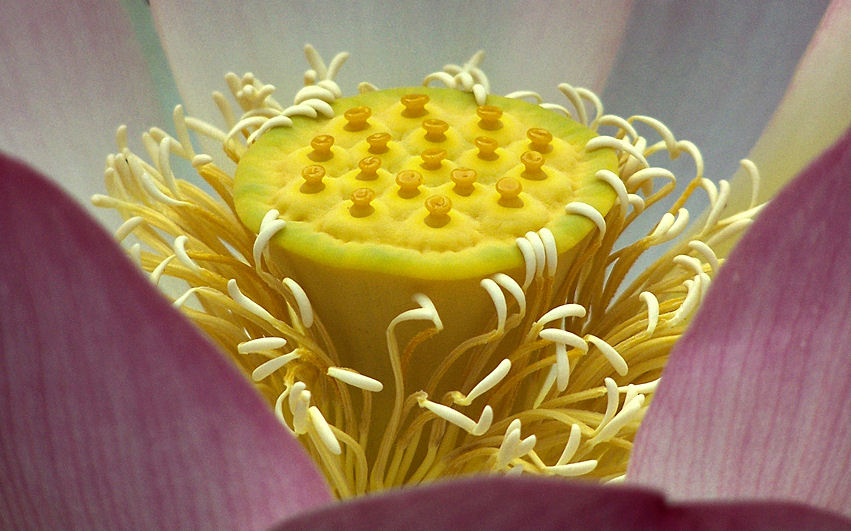
Abb.: केसराणि ।
[Bildquelle: T.Voekler / Wikimedia. --
Creative Commons
Lizenz (Namensnennung, share alike)]
43. c./d. saṃvartikā navadalaṃ bījakośo varāṭakaḥ
संवर्तिका नवदलं बीजकोशो वराटकः ॥४३ ख॥
[Bezeichnungen für ein junges (noch zusammengerolltes) Lotusblatt sind:]
संवर्तिका f.: Zusammengerollte, junges (noch zusammengerolltes) Lotusblatt
नवदल n.: neues Blatt
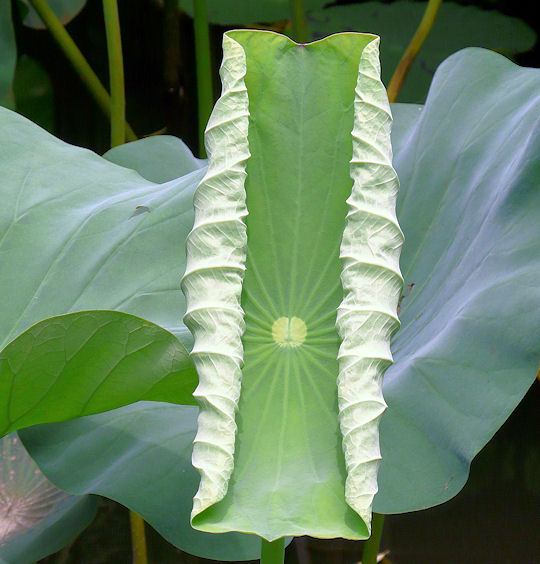
Abb.: संवर्तिका ।
[Bildquelle: Hans Bernhard / Wikimedia. -- GNU FDLicense]
43. c./d. saṃvartikā navadalaṃ bījakośo varāṭakaḥ
संवर्तिका नवदलं बीजकोशो वराटकः ॥४३ ख॥
[Bezeichnungen für Lotus-Samenkapsel sind:]
बीजकोश m.: Samenbehälter
वराटक m.: Kauri, Lotus-Samenkapsel
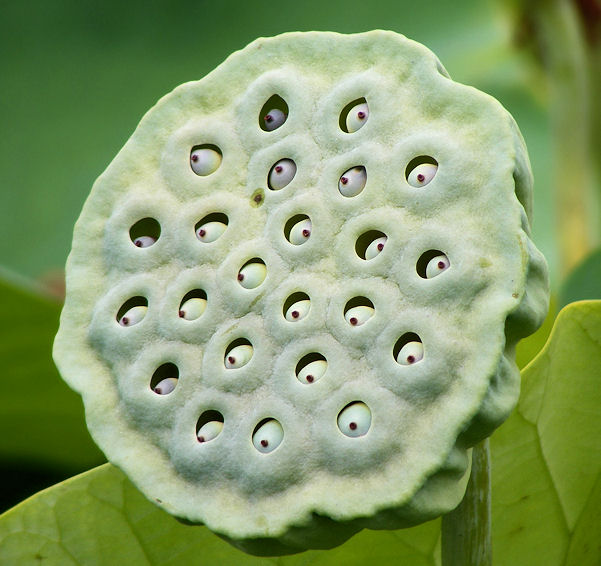
Abb.: बीजकोशः ।
[Bildquelle: Peripitus / Wikipedia. -- GNU FDLicense]
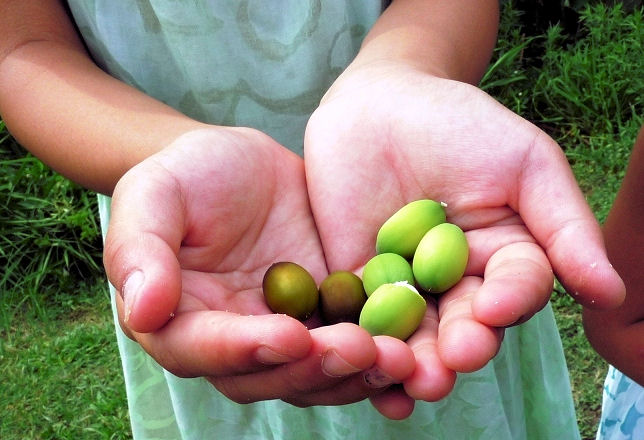
Abb.: बीजानि ।
[Bildquelle: VoDeTan2 Dericks-Tan / Wikipedia. -- GNU FDLicense]